ETHIOPIA - Its History, Stamps, Overprints and Postmarks
Quote from Steve on February 6, 2024, 3:34 pmEthiopia's First Postmarks and the Mystery of the Egyptian Harrar Canceller
If only .... a recreation of the Maltese Cross handstamp cancelling Egyptian stamps as used in Harrar in 1875.
Where is the proof that Egypt made then used this Maltese Cross canceller in Harrar?
Why would a Muslim occupier use a Christian Cross?The British Army ran the first postal system in Ethiopia during its 1867 - 1868 'Abyssinia' campaign.
The Khedivate of Egypyt operated a post office in Harrar from 1875 - 1885.
Ethiopia would start a limited postal system in 1895.The trove of early Ethiopian postal history is small. For over two decades Luciano Maria, a member of the Ethiopian Philatelic Society, studied collections and auction catalogues to record covers and cards from Ethiopia's pre-UPU period, (1895 - 1908). His work recorded some 1,100 items. This is not exactly a trove. Little survives from the earliest days of the Ethiopian Post Office. Of the first mail despatched from Addis Ababa on 29th May 1895 only one cover is known. The rarity and consequent expense of early Ethiopian postal history forces the author to concentrate on its stamps, their overprints and postmarks, as well as ephemera from the period. Your covers and comments are welcomed.
While there will be other new examples unseen by Maria, he has arguably recorded the majority of surviving early Ethiopian mail. Some of that postal history which he has recorded was contrived by unscrupulous Europeans employed by the Ethiopian Post Office to subsidise their salaries! The malign or beneficial - you take your pick - influence of French postal officials on Ethiopian philately has resulted in a huge number of contrived varieties, almost all of which were deliberately intended to enrich themselves. Ironically, Ethiopia's postal heritage resulted from a desperate need to modernise in order to stave off colonisation but in the process of starting a post office Africa's last independent nation was shamelessly exploited at every turn by those bought in to oversee its development.
Who are the Ethiopians?
In the 8th c. BCE, the poet Homer used 'Ethiopian' three times in the 'Odyssey' and twice in the 'Iliad', some 400 years before Herodotus, the first known Western historian to describe Africa which he called 'Libya'. This was largely divided by the Nile as it passed through the territories of Aethopia, Nubia and Egypt.Herodotus called the inhabitants of Libya's southern fringes 'Ethiopians', (Greek. burnt-face and or red-brown), people with darker skins than the Greeks. Sub-Saharan Africa was unknownt below the Horn of Africa.
The King James Bible (published 1611) contains 12 verses in eight Books that reference 'Ethiopians' as enemies of Israel, usually as allies of Egypt. At this time 'Ethiopia' probably refers to areas within the Kingdom of Kush or Nubia in northern Sudan. This included the Nubian Desert along the Nile river between its first cataract just south of Aswan in southern Egypt and the confluence of the Blue and White Niles in Khartoum in central Sudan. This was probably not the country of mountainous highlands that we call 'Ethiopia' today.
Chronicles 2 describes how King Rehoboam of Israel "transgressed against the LORD" and as a result, Shisak, King of Egypt, "came up against Jerusalem .... With twelve hundred chariots, and threescore thousand horsemen: and the people [were] without number that came with him out of Egypt; the Lubims, the Sukkiims, and the Ethiopians." The Ethiopians were, apparently, foot soldiers "that handle the shield" (and presumably the sword and spear). At this point. Ethiopia was probably a tributary state allied to Egypt.
Later Kings and Emperors of Ethiopia would claim a lineage from 10th C. BCE King Solomon of Israel and the Queen of Sheba, the 'Queen of the South' who converted to Judaism on a visit to Jerusalem. Trade via the Nile, Egypt and the Red Sea was at the heart of the Queen's agenda. Ethiopia's national saga holds that Menelik I was the child of the union of Solomon and Sheba, the legendary founder of the Solomonic dynasty that lasted into the 18th c. Historically, however, it is more likely that the origin of modern Ethiopia lie in the once powerful Axumite civilisation which took root in northern Ethiopia in the mid-second century BC.
The Kingdom of Axum controlled the trade routes surrounding the Red Sea. Aksum was situated inland but was linked to the Red Sea trade routes by its port city of Adulis. Ivory was a vital component of its export trade. Axumites occupied parts of Yemen. While distinctions existed, Axumites were often commonly called 'Ethiopians'. As a distant southern fringe of the Greek-influenced world, Axum was not immune to international developments, like the growth of Christianity. In the 4th c. AD, the Axumite Emperor Ezana adopted Christianity. His decision to do so was likely influenced by a desire to consolidate his trading relationship with Christian merchants within the Roman Empire and also to unify his disparate multi-cultural kingdom.
After adopting Coptic Christianity in the 4th c. AD, Axum prospered enough for it to become the world's first state to put a Cross, the symbol of Christianity, on its coinage. However, the emergence of Islam in Arabia in the 7th c. AD and its rapid advance across the region ultimately deprived Axum of its Red Sea trading ports and lead to its disappearance from the map. In Europe little would be remembered about Axum or Ethiopia during the Middle Ages other than it was the imagined home of a fabled African Christian king called ‘Prester John’. Its importance as one of the two sources of the Nile was forgotten. Ethiopia became a land of mystery.
During the medieval period Ethiopia experienced pressure from outside. It became a land-locked country surrounded on all sides by enemies. It fought stubbornly to maintain its identity, freedoms and land from Muslim encroachment, so much so that the Arab slave trade in 'kaffirs', (Arabic. unbelievers) turned to the easier pickings of the animist African lands of East and Centra Africa. This was a commercial pillar of Arab regional trade, one supported by the tenets of Islam. Those Africans and Ethiopians who were unable to withstand the Muslim advance had a stark choice - convert to Islam or become enslaved. Most Ethiopians chose to stand and fight.
During this little known period of lost wealth and influence, the Zagwe dynasty emerged in the northern Ethiopian highlands from obscure origins. It ruled Ethiopia until 1270 when it was overthrown by the Amharic Emperor Yekuno Amlak who had the support of the Ethiopian Church. The new Emperor claimed his legitimacy from an Axumite lineage traceable back to Solomon and the Queen of Sheba. This marked the start of the so-called Early Solomonic period (1270–1530). Some historian's argue that the Solomonic myth and dynasty started at this time as a response to the threat that Islam posed to Ethiopia's weakened sense of national identity.
At some point the state known as Ethiopia today began to be called 'Abyssinia' in Europe during the late Middle Ages. The most likely is that 'Abyssinia' derives from 'al-Habash', (Arabic. 'mongrel' or 'mixed'), referring to a multi-cultural society or a people with a strong Coptic Christian culture, one which while not pagan animist like most Black Africans was also one of unbelievers to devout Muslims.
In the late 15th c. the first European explorers, the Portuguese rounded the Cape. They took and used the dominant Moslem names for people and places. The Portuguese used the Arabic Habaśā to describe Ethiopia which over time became 'Abyssinia' in English and also used 'kaffir' to describe all Black people, unlike Moslems who only used it to describe people who were not followers of Islam. By the time the Portuguese reached India, succesful Islamic invasions had largely overrun the Ethiopian Coptic kingdom which was reduced to fighting a guerilla war from mountain strongholds. The news that the Portuguese, fellow Christians, had entered the Indian Ocean and were slaughtering Moslems by the thousand was welcomed in Ethiopia, no doubt as a sign from a just and merciful God.
The Portuguese would eventually come to Ethiopia's aid and enable them to recove their lost lands. However, the Islamic status quo as imposed by the Ottoman Turks, the regional superpower controlling the Middle East, the Arabian Peninsula and eventually Egypt, would restrict the ability of Ethiopia to colonise Axum's old lands adjoinuing the Red Sea. Ethiopia's lack of direct access to the sea would become a great disadvantage at a time when it needed access to the outside world in order to modernise. It increasingly became the ambition of its conquering emperors to control if not occupy the coastal plains.
The stamp below, 'Ethiopia with Her Sea Borders', shows the last Emperor of Ethiopia, Haile Selassie 1, (1930 - 1974), gazing with pride upon the United Nation's post-WW2 gift of Eritrea in 1952. The UN intended this ex-Italian colony to be ruled as an autonomous region within a federated Ethiopia. However, the autocratic Selassie dissolved the federation and annexed Eritrea in 1970. A 30 year-long war of Eritrean resistance led to Ethiopia's military and political defeat in 2000. Sellasie's failure saw him was deposed by a communist military coup and strangled to death while under house arrest in 1975. Thus ended Africa's oldest royal lineage.
1952. Emperor Hailie Selassie surveys his domain which includes Eritrea.
This map shows Ethiopia's province of Eritrea (with the towns of Asmara and Massawa).
When Ethiopia annexed the territory it resulted in a bitter war for Eritrean independence.The United Nations General Assembly's decision, taken in 1950, that Eritrea, a former Italian colony, should be federated with Ethiopia following the Second World War owes much to Major General Frank Theron, a South African soldier and UN diplomat with post-WW2 responsibility for the disposal of Italian colonies.
After the Catholic Portuguese sailed around to southern tip of Africa to India in 1498 their caravels and cannon soon dominated the once pacific trading pond that was the Islamic Indian Ocean. Much of this trade was controlled the Mamluk Empire of Egypt. After the Adal Sultanate declared Jihad against Ethiopia in 1529, the Ethiopians appealed to the Portuguese for military assistance. A Portuguese fleet under the command of Estevao da Gama, son of Vasco, was sent from India and arrived at Massawa in February 1541. At the Battle of Wayna Daga in February 1543 the invading Islamists were routed, their leader killed. Ethiopia resisted paying the price demanded by the Portuguese, conversion to Roman Catholicism. It kept its Coptic faith and identity and slowly adjusted to a changing African world.
Left. Portuguese Naval War Banner - The Cross of the Order of Christ.
This symbol is an anthema to the followers of Islam.
Why would Muslim Egypt use a Maltese Cross as a postmark canceller, a symbol of its authority, when this Portuguese symbol destroyed its ancient Indian Ocean trade and impoverished it for 300 years?
Right. The British (English) White Ensign incorporating the Cross of St George.
This symbol would replace the Portuguese one as the dominant naval and maritime power in the Indian Ocean and the world.
Top Left. Adler's Egyptian Maltese Cross Canceller. Above right. 1915. Cigarette Card Silk Flag.
When this silk flag was first issued in 1915 during the First World War the Ottoman Turks under the banner of the Star and Crescent had succeeded in mining and closing the Suez Canal, thereby briefly pausing the passage into the Red Sea of British naval and commercial fleets en route to the riches of India and south-east Asia. The defeat of the Ottoman Empire would spur the rise of pan-Arab Nationalism and anti-Western sentiment.
Vicious Portuguese naval successes against Muslim commercial fleets and the capture of trading posts in India caused a huge power shift. The Egyptian Mamluk Empire was financially crippled by the loss of its Indian Ocean trade. With half its forces fighting the Portuguese, it was unable to defend itself from attack by the Ottoman Empire which captured Cairo in January 1517. The Ottoman Turks resolved to recapture the Indian Ocean trade but found the Portuguese an unyielding opponent. They limited their ambition and settled for dominating the Red Sea. To this end, they occupied the port of Massawa in 1557 and thereafter sought to establish hegemony over the coastal areas. Deprived of its ancient Indian Ocean trade, Egypt and the surrounding Muslim world suffered three centuries of decline.
The Lion of Judah, The King of Kings. A stamp from Ethiopia's first issue in 1894.
The Ethiopians were unable to take full advantage of this decline. In the 16th and 17th Centuries it experienced encroachment from the Oromo people of Kenya who would gain power and status. This time between the mid-18th and mid-19th Centuries is known in Amharic as the 'Zemene Mesafint', ("Era of the Princes"), a period of rule by a class of Oromo elite noblemen who replaced traditional nobility in their courts, making the Ethiopian Emperor merely a figurehead. The Princes fought against each other for the expansion of their territory and to become the guardians of the Kings of Kings in Gondar, then the capital of the empire. The monarchy existed in name only because of its sacred character. This era of divisive rule by feuding Princes made Ethiopia appear weak and divided.
Ethiopia was united by Emperor Tewedros (Theodor) II in the mid-19th Century. He defeated his Oromo rivals and ended the divisive, decentralised 'Age of the Princes'. His reforms were worthy and necessary but hugely unpopular. The talented Tewedros failed to turn his sullen, lip-serving enemies into allies. With his power base small and limited, he was constantly fighting rebellions. In 1862 his poorly equipped army was defeated by Ottoman Egypt and Muslim tribesmen to the south. Nevertheless, he was Ethiopia's first moderniser. His brief reign saw Ethiopia emerge from medieval darkness into the harsh light of the modern world, one in which his country, Ethiopia, was Africa’s last independent kingdom in a continent carved-up by the great European imperial powers.
Circa 1895. A tradional Ethiopian Méléktegnas or postal courier.
Until the start of the Ethiopian Post Office their mail was unstamped and uncancelled.
Do any examples survive?Before an Ethiopian postal system was started by Imperial edict in 1894, government officials, aristocrats and literate high status Ethiopians forwarded correspondence by special couriers called Méléktegnas who travelled on foot, by horse, mule or camel. They were under the protection of Imperial decree and carried the mail visibly attached to a stick. It was forbidden to trouble them. Official and urgent mail was delivered by express couriers who had the right of requisition. People owed them hospitality. ('Handbook of the Postage Stamps of the Empire of Ethiopia and Her Postal System’. Part 1. Ivan Adler, Knight of the Star Order of Ethiopia, Stockholm, Sweden. 1961.)
With its traditional Muslim enemies surrounding it now subjugated as European colonies Tewedros was fully aware that Ethiopia's choice was 'modernise or be colonised'. His army in particular needed modern weapons if Ethiopia was to retain its independence. He decided to appeal to Queen Victoria for help. Tewodros asked the British Consul in Ethiopia, Captain Charles Duncan Cameron, to take a letter from him to Queen Victoria requesting that Britain supply skilled workers who could train his subjects in the production of firearms, artillery and munitions. He hoped that she as a fellow Christian Monarch would aid him against his Muslim enemies.
The letter never reached Queen Victoria. Bungling bureaucrats in the Foreign Office got their hands on it and decided it was inappropriate for Her Majesty. The letter was filed away in India to gather dust. When Tewodros did not receive a response, he pereceived a royal snub. He fell into a fit of rage and unreasonably took a number of British missionaries hostage. Diplomats sent to obtain their release were also taken hostage. Had the letter been delivered to Queen Victoria, Britain may well have created and gained a powerful regional anti-Ottoman ally in Ethiopia. The History of WW1's Middle East campaign might have been quite different.
Two Invading Armies start Foreign Post Offices in Ethiopian Territory in 1867 and 1875
The Burning of Magdala, Tewedros' Mountain Fortress in 1868.
It shows Ethiopia as a country of high mountains and deep abysses.Napier's 'Abyssinian Campaign': 1867
The British decided to invade Ethiopia to free the hostages. Under the leadership of Lieutenant-General Robert Napier, a first-rate engineer, the British Army had to overcome a series of technical challenges before it could march across the many obstacles in its way. Negotiations with the Egyptians and Ottomans gained the British a stretch of coast line on the Red Sea at Zula for use as its African logistics base. An EFFAPS (Ethiopian Field Force Army Postal Service) was set up under the auspices of the Indian Government in October 1867 for the benefit of the Anglo-Indian troops. As the Army moved toward Tewedros' mountain fortress capital of Magdala, 600 km away, Army Post Offices were established at Kumayler, SanCafe, Addigrat, Hentalo, also with each Brigade
Napier invading force comprised some 13,000 soldiers, mostly Indians, 26,000 camp followers and over 40,000 animals. (You would imagine a small but reasonable body of postal history emerging from this nine month campaign.) Napier soon found allies among the conquered Princes, many of whom had come out in active revolt against Tewedros whose Army disintegrated as Napier advanced. After the loyal remnant of his army was defeated with heavy casualties, Tewedros chose death before dishonour. Magdala, his fortress city, was burned and the hostages freed. Having no interest in Ethiopia, the British departed in June 1868, via Zula. The EFFAPS closed with no benefits accruing to the later Ethiopian postal system. From the ashes of Ethiopian defeat a more cohesive Ethiopian state arose.
As the British storm his shattered fortress, Tewedros commits suicide with a pistol sent to him by Queen Victoria.
"I will rather put myself in the hands of God than in those of my enemies," he wrote.
He freed the hostages but had 300 traitors thrown off the parapets before he killed himself.Following Tewedros' death and also that of his successor, Emperor John, in battle against Mahdists, the Khedivate of Egypt, an autonomous tributary state of the Ottoman Empire, and Italy were tempted to take control of some of the coastal regions, like the Ethiopian province of Harrar (Egypt. 1875) and Italian Eritrea (1882)and Somaliland (1889).
The first canceller used in Ethiopia
According to Adler, "the first postal system in Ethiopia was arranged by the British in Massawa on November 25th 1867 and lasted until June 1868." (Note: Zula is some 50km south of Massawa.) "During this time the stamps of India were used." Adler's statements raise a questions. If stamps were needed, which datestamp or canceller was used to obliterate them?
As Napier's Army was assembled in India with the agreement of the Indian government, it was very largely an Indian Field Force. It is appropriate then that "the stamps of India were used." But does this mean that an Indian Army Field Post Office datestamp or canceller was used and if so, which one? This would presumably be the first canceller used in Ethiopia.
Tewedros’ grandson, the King of Shewa (1866 to 1889), would ascend the ‘Throne of Solomon’ as Emperor Menelik II in 1889. A great moderniser, he introduced a postal system in 1895, later the telegraph, telephones, roads and railways. He initially enjoyed a good relationship with Italy who as a late participant in the European ‘Scramble for Africa’ desired a colonial African empire beyond its coastal possesions of Eritrea and Somaliland. Menelik wanted and got modern weapons. With them he won Ethiopia's and Africa's greatest victory over an invading Europeam army, the Italians at Adwa in 1896. Like the Sioux fighting the US 7th Cavalry at the Battle of the Little Big Horn twenty years earlier, Menelik's Ethiopian army fought an over-confident enemy while enjoying the benefit of more modern rifles and cannon. Penny-pinching Italian economics armed their soldiers with old rifles and sub-standard ammunition.
The Khedivate of Egypt's Invasion: 1875 - 1885
Napier’s success suggested to others - Egypt, Sudanese Mahdists and Italy - that Ethiopia was weak and vulnerable. After Tewedros' suicidePrince Gobaze became Emperor John of Ethiopia in 1872. He suppressed a rebellion and twice defeated an Egyptian Army intent on conquering Ethiopia in 1875 and 1876. His death from wounds received in a defeat by Sudanese Mahdists in 1889 gave the throne to Menelik II.
The second postal service to be run in Ethiopia was also the result of foreign invasion. Since the dawn of time, Egypt has wanted - and still wants - to expand southwards to take full control of the source of the Nile, its seasonal lifeblood. In 1874 the Khedivate of Egypt sensed a weakness in Ethiopia and decided to expand southwards at the expense of the Coptic Christian empire. Advancing from the Red Sea it occupied Harar province on Ethiopia's south-eastern flank. Today, Harar is today one of Ethiopia's main cities, but from 1875 - 1885, the independent Emirate of Harrar and the tribal area between it and the Somali port cities of Berbera and Zeila was under Egyptian occupation.
"A mute postmark in the design of a large Maltese cross"
According to Adler, "Reof Pascha .... built in 1876 a post office at Harrar in 1876. Until 1886 Egyptians used Egyptian stamps of 1867 - 1872 which were cancelled by a mute postmark in the design of a large Maltese cross".
The design of this 'Maltese Cross' appears to be more Ethiopian in style than Egyptian.
The faith of Islam is symbolized by the Crescent and Star. These are found in early Egyptian watermarks.
It is Adler who says that this is an 'Egyptian canceller', later an 'Egyptian postmarker'.
Much like a sophisticated cork canceller, this design is relatively easy to fabricate.Why would the Egyptians who were predominantly Muslim use a Maltese Cross? This would be an anathema to them. Given the French postal presence in Egypt ever since Napoleon's Campaign, especially its post offices and postmarks it used there, the suggestion has been made that perhaps the Maltese Cross was a French device that somehow percolated down to the Khedivate of Egypt in Harrar. I can find no proof for this. Early French Egyptian postmarks are typical of European design of the time. This Maltese Cross is 'unique'.
As a result of these two invasions, the first two postmarks used in Ethiopia for postal purposes were British, probably Anglo-Indian. and Egyptian, not Ethiopian. It would be useful if someone could post an item from the British invasion of 1867 - 1868 so we can see what was used. When the Egyptians withdrew from Harrar in 1886, they left the mute Maltese Cross canceller in Harrar. This suggest they had no use for it in Egypt. Was it ever Egyptian? Was it not an ad hoc canceller made in Harrar by an Ethiopian for the Egyptians, the design of the cross being not-so-subtle comment that Egyptian Harrar was in reality Coptic Christian Ethiopia? Let's not forget that Egypt also had a large Coptic Christian minority. Perhaps this made the Maltese Cross canceller more acceptable?
Following the Egyptian withdrawal from Harrar in 1885, the expansionist Menelik II quickly absorbed his previously lost province and its Maltese Cross canceller back into his Empire. It would be at least ten years before the Maltese Cross canceller was used to cancel an Ethiopian stamp.
A mute postmark in the shape of a Maltese cross used in Addis Ababa in 1897.
Alfred Ilg was a Swiss engineer who been an advisor to Emperor Menelik II since he was King of Shoa. Not being French, British or Italian, the neutral non-colonialist Ilg was valued as a source of impartial advice and as a procurer of modern European weapons. In early 1892, Menelik accepted Ilg's suggestion that stamps be printed bearing his portrait. This rather put the cart before the horse as no Ethiopian Post Office existed at the time of Ilg's flattering suggestion.On 10th February 1893, Ilg received the news that he had probably been fishing for, namely that Menelik had granted him a concession to start a private Ethiopian postal system. As a result, in early in 1893 an order was placed with the world-famous French engraver Louis-Eugène Mouchon for a set of seven Ethiopian stamps.
1894. The first set of seven Ethiopian stamps.
The values of ¼, ½, 1 and 2 guerch (g) showg portrait of Emperor Menelik II in profile.
The 4, 8, 16g values show the heraldic Lion of Judah.
The printer was Atelier du Timbre in Paris. They are neither common nor scarce.After the strong box containing the Atelier du Timbre stamps, etc., arrived by camel caravan at the Ethiopian border it reached Harrar in July 1894 where it was deposited in the Franciscan Catholic mission. According to Adler, "the first postal experiments with the stamps started in Harrar in January 1895. Mr Gattiker, a brother of Mrs Ilg, arrived in Ethiopia from Europe in June 1895." He bought with him to the Cathloic mission two cancellers. According to Adler these were "a canceller with European and Amharic lettering and Amharic date, and a similar one but with date in European type". According to Ulf Lindahl, the first postmarks looked like these below. They are taken from his Gold Medal winning 'Early Ethiopia 1895 - 1913' display. Lindahl's examples shown below show two, not one, "canceller(s) with European and Amharic lettering and Amharic date", as Adler attributes to Mr Gattiker.
The postmark below fits Adler description of "a canceller with European and Amharic lettering .... and a similar one but with date in European type." However, given the postmark above, one assumes (!) that the one below should perhaps be in the same style of design ie. the inner circle divided in three to accomodate a European / Arabic date format.
1897. Early-ish examples from Harrar ex-Ulf Lindahl's Gold Medal winning 'Early Ethiopia 1895 - 1913' display.
Readers interested in Ethiopian Postal History absolutely must view it.
Search for the Ethiopian Philatelic Society to see it displayed in all its glory.
I have tried to make a link but it keeps timing out.Until the postal system came under Ethiopian management, Adler says “postal tasks were entrusted to the priests .... at Harrar”. He adds that “the Egyptian postmarker was used .... for cancelling stamps on private letters .... by these priests.” Presumably, this "Egyptian postmarker" refers to Harrar's old Khedivate of Egypt mute Maltese Cross canceller, not Gattiker's European-made ones? Unfortunately for Ethiopia and its nascent postal system the Italians now invaded their country. The new post office was subordinated to the exigencies of the war. Only after its conclusion following Italian defeat at Adwa in March 1896 did the post office resume service.
Ulf Lindahl's Gold Medal winning 'Early Ethiopia 1895 - 1913' display shows a wonderful postcard on a sheet headed 'Emergency Use of Maltese Cross in Addis Ababa, January - March 1897'. This has a 1 guerche blue Menelik II portrait stamp cancelled with a Maltese Cross in Addis Ababa, manuscript dated February 24 1897. Lindahl says "Entotto's first canceller was lost at the end of 1896; a mute "Maltese Cross" was used instead for three months to cancel the mail in Addis Ababa until the Entotto canceller (delivered in 1896) began to be used in April 1897".
Is this the same Maltese Cross canceller used in Harrar by the Khedivate of Egypt and the Catholic Mission? If so, the above is an example of one of the first two foreign cancellers used in Ethiopia before the start of its postal system.
However, its date of use in Entotto precedes the Catholic mission's return of the strong box almost three years later. Adler tells us that after three Swiss postal officials arrived in Ethiopia to better organise its post office, the Catholic mission in Harrar handed over its stock of stamps in late 1899 / early 1900 on the request of Swiss postal official, Herr Wullschleger. The mission provided him with:
899 of each sheet from ¼ to 16g in value, a total of 6293 sheets,
(this number included the 100 sheets sent to Gattiker in January 1895),
a wrapper containing the original 200 ‘provincial blocks’,
a canceller without any date, (the Maltese Cross),
a HARRAR canceller with Amharic date, and a
canceller with a European date, (presumably also HARRAR).This tells us that 'a canceller without any date' (presumably the Maltese Cross?) was in Harrar in late 1899 / early 1900. Had it been in Harrar all along or was it returned to Harrar after it was used in Entotto as a temporary replacement canceller in 1897. Are they different or the same?
However, it could be that it did go to Entotto as a temporary replacement canceller. At this time the Catholic Mission was having its postal activities cut back as Ilg's postal service took root. They may not have had a need for it. If it is true they had little or no use for it, why was it returned to be listed in Herr Wullschleger's stock-taking? A third explanation is that the description "a canceller without a date," refers to another canceller altogether and that the idea this is Adler's "Maltese Cross" is wishful thinking on his part.
So, if this canceller is not the Egyptian Harrar canceller, what is it? Some expert advice would be appreciated!
Anyone interested in Ulf Lindahl's magnicent Gold Medal winning 'Early Ethiopia 1895 - 1913' display should search for the Ethiopian Philatelic Society where it is displayed in all its glory. I have tried to make a link but it keeps timing out.
Ethiopia's First Postmarks and the Mystery of the Egyptian Harrar Canceller
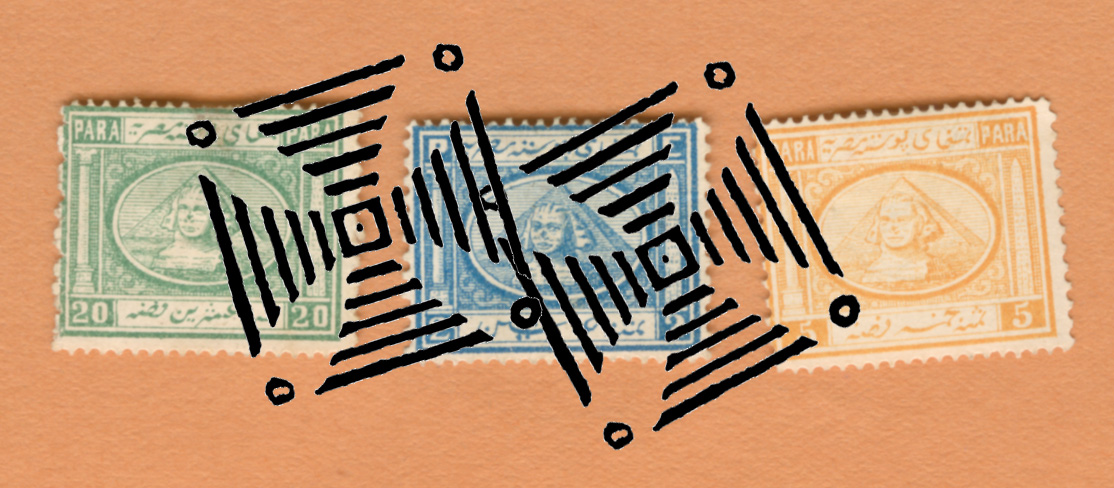
If only .... a recreation of the Maltese Cross handstamp cancelling Egyptian stamps as used in Harrar in 1875.
Where is the proof that Egypt made then used this Maltese Cross canceller in Harrar?
Why would a Muslim occupier use a Christian Cross?
The British Army ran the first postal system in Ethiopia during its 1867 - 1868 'Abyssinia' campaign.
The Khedivate of Egypyt operated a post office in Harrar from 1875 - 1885.
Ethiopia would start a limited postal system in 1895.
The trove of early Ethiopian postal history is small. For over two decades Luciano Maria, a member of the Ethiopian Philatelic Society, studied collections and auction catalogues to record covers and cards from Ethiopia's pre-UPU period, (1895 - 1908). His work recorded some 1,100 items. This is not exactly a trove. Little survives from the earliest days of the Ethiopian Post Office. Of the first mail despatched from Addis Ababa on 29th May 1895 only one cover is known. The rarity and consequent expense of early Ethiopian postal history forces the author to concentrate on its stamps, their overprints and postmarks, as well as ephemera from the period. Your covers and comments are welcomed.
While there will be other new examples unseen by Maria, he has arguably recorded the majority of surviving early Ethiopian mail. Some of that postal history which he has recorded was contrived by unscrupulous Europeans employed by the Ethiopian Post Office to subsidise their salaries! The malign or beneficial - you take your pick - influence of French postal officials on Ethiopian philately has resulted in a huge number of contrived varieties, almost all of which were deliberately intended to enrich themselves. Ironically, Ethiopia's postal heritage resulted from a desperate need to modernise in order to stave off colonisation but in the process of starting a post office Africa's last independent nation was shamelessly exploited at every turn by those bought in to oversee its development.
Who are the Ethiopians?
In the 8th c. BCE, the poet Homer used 'Ethiopian' three times in the 'Odyssey' and twice in the 'Iliad', some 400 years before Herodotus, the first known Western historian to describe Africa which he called 'Libya'. This was largely divided by the Nile as it passed through the territories of Aethopia, Nubia and Egypt.Herodotus called the inhabitants of Libya's southern fringes 'Ethiopians', (Greek. burnt-face and or red-brown), people with darker skins than the Greeks. Sub-Saharan Africa was unknownt below the Horn of Africa.
The King James Bible (published 1611) contains 12 verses in eight Books that reference 'Ethiopians' as enemies of Israel, usually as allies of Egypt. At this time 'Ethiopia' probably refers to areas within the Kingdom of Kush or Nubia in northern Sudan. This included the Nubian Desert along the Nile river between its first cataract just south of Aswan in southern Egypt and the confluence of the Blue and White Niles in Khartoum in central Sudan. This was probably not the country of mountainous highlands that we call 'Ethiopia' today.
Chronicles 2 describes how King Rehoboam of Israel "transgressed against the LORD" and as a result, Shisak, King of Egypt, "came up against Jerusalem .... With twelve hundred chariots, and threescore thousand horsemen: and the people [were] without number that came with him out of Egypt; the Lubims, the Sukkiims, and the Ethiopians." The Ethiopians were, apparently, foot soldiers "that handle the shield" (and presumably the sword and spear). At this point. Ethiopia was probably a tributary state allied to Egypt.
Later Kings and Emperors of Ethiopia would claim a lineage from 10th C. BCE King Solomon of Israel and the Queen of Sheba, the 'Queen of the South' who converted to Judaism on a visit to Jerusalem. Trade via the Nile, Egypt and the Red Sea was at the heart of the Queen's agenda. Ethiopia's national saga holds that Menelik I was the child of the union of Solomon and Sheba, the legendary founder of the Solomonic dynasty that lasted into the 18th c. Historically, however, it is more likely that the origin of modern Ethiopia lie in the once powerful Axumite civilisation which took root in northern Ethiopia in the mid-second century BC.
The Kingdom of Axum controlled the trade routes surrounding the Red Sea. Aksum was situated inland but was linked to the Red Sea trade routes by its port city of Adulis. Ivory was a vital component of its export trade. Axumites occupied parts of Yemen. While distinctions existed, Axumites were often commonly called 'Ethiopians'. As a distant southern fringe of the Greek-influenced world, Axum was not immune to international developments, like the growth of Christianity. In the 4th c. AD, the Axumite Emperor Ezana adopted Christianity. His decision to do so was likely influenced by a desire to consolidate his trading relationship with Christian merchants within the Roman Empire and also to unify his disparate multi-cultural kingdom.
After adopting Coptic Christianity in the 4th c. AD, Axum prospered enough for it to become the world's first state to put a Cross, the symbol of Christianity, on its coinage. However, the emergence of Islam in Arabia in the 7th c. AD and its rapid advance across the region ultimately deprived Axum of its Red Sea trading ports and lead to its disappearance from the map. In Europe little would be remembered about Axum or Ethiopia during the Middle Ages other than it was the imagined home of a fabled African Christian king called ‘Prester John’. Its importance as one of the two sources of the Nile was forgotten. Ethiopia became a land of mystery.
During the medieval period Ethiopia experienced pressure from outside. It became a land-locked country surrounded on all sides by enemies. It fought stubbornly to maintain its identity, freedoms and land from Muslim encroachment, so much so that the Arab slave trade in 'kaffirs', (Arabic. unbelievers) turned to the easier pickings of the animist African lands of East and Centra Africa. This was a commercial pillar of Arab regional trade, one supported by the tenets of Islam. Those Africans and Ethiopians who were unable to withstand the Muslim advance had a stark choice - convert to Islam or become enslaved. Most Ethiopians chose to stand and fight.
During this little known period of lost wealth and influence, the Zagwe dynasty emerged in the northern Ethiopian highlands from obscure origins. It ruled Ethiopia until 1270 when it was overthrown by the Amharic Emperor Yekuno Amlak who had the support of the Ethiopian Church. The new Emperor claimed his legitimacy from an Axumite lineage traceable back to Solomon and the Queen of Sheba. This marked the start of the so-called Early Solomonic period (1270–1530). Some historian's argue that the Solomonic myth and dynasty started at this time as a response to the threat that Islam posed to Ethiopia's weakened sense of national identity.
At some point the state known as Ethiopia today began to be called 'Abyssinia' in Europe during the late Middle Ages. The most likely is that 'Abyssinia' derives from 'al-Habash', (Arabic. 'mongrel' or 'mixed'), referring to a multi-cultural society or a people with a strong Coptic Christian culture, one which while not pagan animist like most Black Africans was also one of unbelievers to devout Muslims.
In the late 15th c. the first European explorers, the Portuguese rounded the Cape. They took and used the dominant Moslem names for people and places. The Portuguese used the Arabic Habaśā to describe Ethiopia which over time became 'Abyssinia' in English and also used 'kaffir' to describe all Black people, unlike Moslems who only used it to describe people who were not followers of Islam. By the time the Portuguese reached India, succesful Islamic invasions had largely overrun the Ethiopian Coptic kingdom which was reduced to fighting a guerilla war from mountain strongholds. The news that the Portuguese, fellow Christians, had entered the Indian Ocean and were slaughtering Moslems by the thousand was welcomed in Ethiopia, no doubt as a sign from a just and merciful God.
The Portuguese would eventually come to Ethiopia's aid and enable them to recove their lost lands. However, the Islamic status quo as imposed by the Ottoman Turks, the regional superpower controlling the Middle East, the Arabian Peninsula and eventually Egypt, would restrict the ability of Ethiopia to colonise Axum's old lands adjoinuing the Red Sea. Ethiopia's lack of direct access to the sea would become a great disadvantage at a time when it needed access to the outside world in order to modernise. It increasingly became the ambition of its conquering emperors to control if not occupy the coastal plains.
The stamp below, 'Ethiopia with Her Sea Borders', shows the last Emperor of Ethiopia, Haile Selassie 1, (1930 - 1974), gazing with pride upon the United Nation's post-WW2 gift of Eritrea in 1952. The UN intended this ex-Italian colony to be ruled as an autonomous region within a federated Ethiopia. However, the autocratic Selassie dissolved the federation and annexed Eritrea in 1970. A 30 year-long war of Eritrean resistance led to Ethiopia's military and political defeat in 2000. Sellasie's failure saw him was deposed by a communist military coup and strangled to death while under house arrest in 1975. Thus ended Africa's oldest royal lineage.
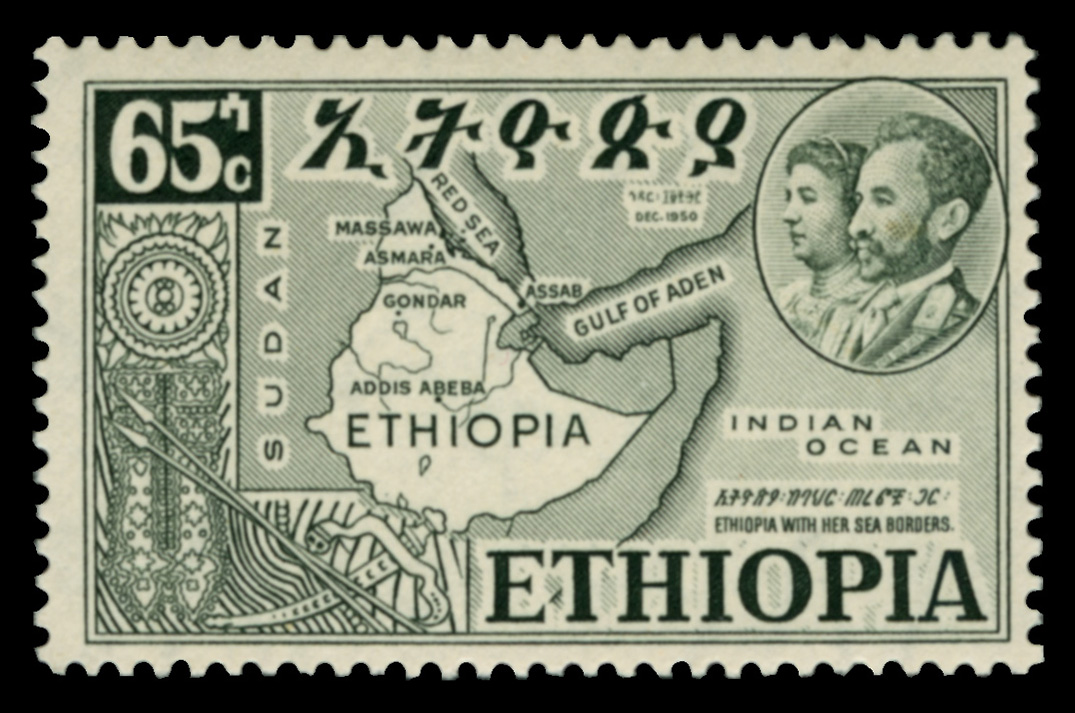
1952. Emperor Hailie Selassie surveys his domain which includes Eritrea.
This map shows Ethiopia's province of Eritrea (with the towns of Asmara and Massawa).
When Ethiopia annexed the territory it resulted in a bitter war for Eritrean independence.
The United Nations General Assembly's decision, taken in 1950, that Eritrea, a former Italian colony, should be federated with Ethiopia following the Second World War owes much to Major General Frank Theron, a South African soldier and UN diplomat with post-WW2 responsibility for the disposal of Italian colonies.
After the Catholic Portuguese sailed around to southern tip of Africa to India in 1498 their caravels and cannon soon dominated the once pacific trading pond that was the Islamic Indian Ocean. Much of this trade was controlled the Mamluk Empire of Egypt. After the Adal Sultanate declared Jihad against Ethiopia in 1529, the Ethiopians appealed to the Portuguese for military assistance. A Portuguese fleet under the command of Estevao da Gama, son of Vasco, was sent from India and arrived at Massawa in February 1541. At the Battle of Wayna Daga in February 1543 the invading Islamists were routed, their leader killed. Ethiopia resisted paying the price demanded by the Portuguese, conversion to Roman Catholicism. It kept its Coptic faith and identity and slowly adjusted to a changing African world.
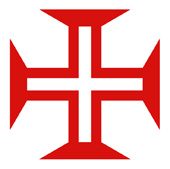
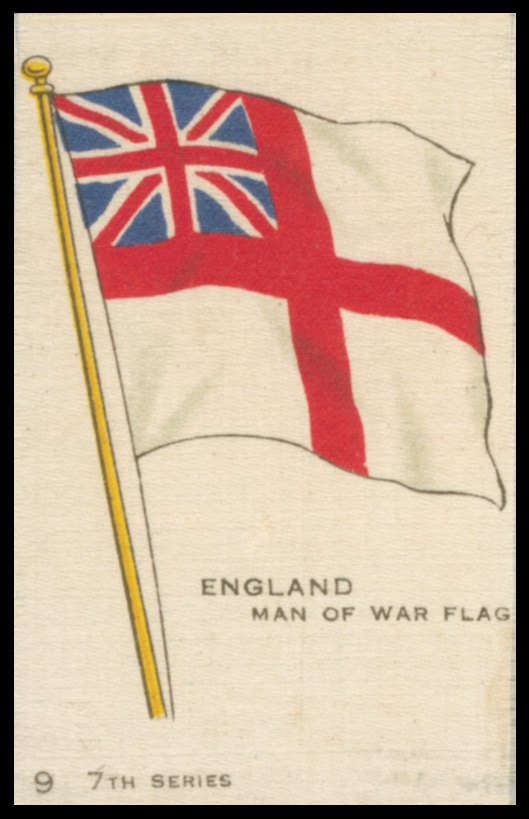 Left. Portuguese Naval War Banner - The Cross of the Order of Christ.
Left. Portuguese Naval War Banner - The Cross of the Order of Christ.
This symbol is an anthema to the followers of Islam.
Why would Muslim Egypt use a Maltese Cross as a postmark canceller, a symbol of its authority, when this Portuguese symbol destroyed its ancient Indian Ocean trade and impoverished it for 300 years?
Right. The British (English) White Ensign incorporating the Cross of St George.
This symbol would replace the Portuguese one as the dominant naval and maritime power in the Indian Ocean and the world.
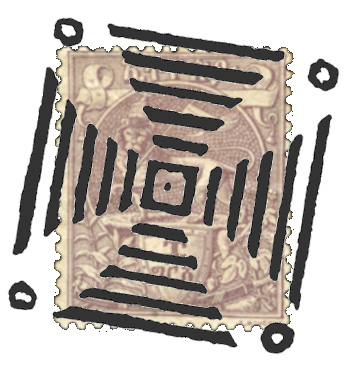
Top Left. Adler's Egyptian Maltese Cross Canceller. Above right. 1915. Cigarette Card Silk Flag.
When this silk flag was first issued in 1915 during the First World War the Ottoman Turks under the banner of the Star and Crescent had succeeded in mining and closing the Suez Canal, thereby briefly pausing the passage into the Red Sea of British naval and commercial fleets en route to the riches of India and south-east Asia. The defeat of the Ottoman Empire would spur the rise of pan-Arab Nationalism and anti-Western sentiment.
Vicious Portuguese naval successes against Muslim commercial fleets and the capture of trading posts in India caused a huge power shift. The Egyptian Mamluk Empire was financially crippled by the loss of its Indian Ocean trade. With half its forces fighting the Portuguese, it was unable to defend itself from attack by the Ottoman Empire which captured Cairo in January 1517. The Ottoman Turks resolved to recapture the Indian Ocean trade but found the Portuguese an unyielding opponent. They limited their ambition and settled for dominating the Red Sea. To this end, they occupied the port of Massawa in 1557 and thereafter sought to establish hegemony over the coastal areas. Deprived of its ancient Indian Ocean trade, Egypt and the surrounding Muslim world suffered three centuries of decline.
The Lion of Judah, The King of Kings. A stamp from Ethiopia's first issue in 1894.
The Ethiopians were unable to take full advantage of this decline. In the 16th and 17th Centuries it experienced encroachment from the Oromo people of Kenya who would gain power and status. This time between the mid-18th and mid-19th Centuries is known in Amharic as the 'Zemene Mesafint', ("Era of the Princes"), a period of rule by a class of Oromo elite noblemen who replaced traditional nobility in their courts, making the Ethiopian Emperor merely a figurehead. The Princes fought against each other for the expansion of their territory and to become the guardians of the Kings of Kings in Gondar, then the capital of the empire. The monarchy existed in name only because of its sacred character. This era of divisive rule by feuding Princes made Ethiopia appear weak and divided.
Ethiopia was united by Emperor Tewedros (Theodor) II in the mid-19th Century. He defeated his Oromo rivals and ended the divisive, decentralised 'Age of the Princes'. His reforms were worthy and necessary but hugely unpopular. The talented Tewedros failed to turn his sullen, lip-serving enemies into allies. With his power base small and limited, he was constantly fighting rebellions. In 1862 his poorly equipped army was defeated by Ottoman Egypt and Muslim tribesmen to the south. Nevertheless, he was Ethiopia's first moderniser. His brief reign saw Ethiopia emerge from medieval darkness into the harsh light of the modern world, one in which his country, Ethiopia, was Africa’s last independent kingdom in a continent carved-up by the great European imperial powers.
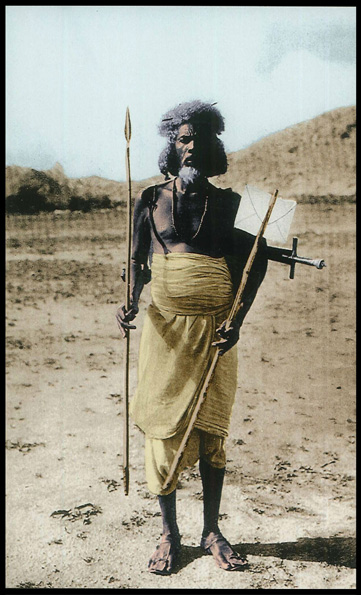
Circa 1895. A tradional Ethiopian Méléktegnas or postal courier.
Until the start of the Ethiopian Post Office their mail was unstamped and uncancelled.
Do any examples survive?
Before an Ethiopian postal system was started by Imperial edict in 1894, government officials, aristocrats and literate high status Ethiopians forwarded correspondence by special couriers called Méléktegnas who travelled on foot, by horse, mule or camel. They were under the protection of Imperial decree and carried the mail visibly attached to a stick. It was forbidden to trouble them. Official and urgent mail was delivered by express couriers who had the right of requisition. People owed them hospitality. ('Handbook of the Postage Stamps of the Empire of Ethiopia and Her Postal System’. Part 1. Ivan Adler, Knight of the Star Order of Ethiopia, Stockholm, Sweden. 1961.)
With its traditional Muslim enemies surrounding it now subjugated as European colonies Tewedros was fully aware that Ethiopia's choice was 'modernise or be colonised'. His army in particular needed modern weapons if Ethiopia was to retain its independence. He decided to appeal to Queen Victoria for help. Tewodros asked the British Consul in Ethiopia, Captain Charles Duncan Cameron, to take a letter from him to Queen Victoria requesting that Britain supply skilled workers who could train his subjects in the production of firearms, artillery and munitions. He hoped that she as a fellow Christian Monarch would aid him against his Muslim enemies.
The letter never reached Queen Victoria. Bungling bureaucrats in the Foreign Office got their hands on it and decided it was inappropriate for Her Majesty. The letter was filed away in India to gather dust. When Tewodros did not receive a response, he pereceived a royal snub. He fell into a fit of rage and unreasonably took a number of British missionaries hostage. Diplomats sent to obtain their release were also taken hostage. Had the letter been delivered to Queen Victoria, Britain may well have created and gained a powerful regional anti-Ottoman ally in Ethiopia. The History of WW1's Middle East campaign might have been quite different.
Two Invading Armies start Foreign Post Offices in Ethiopian Territory in 1867 and 1875
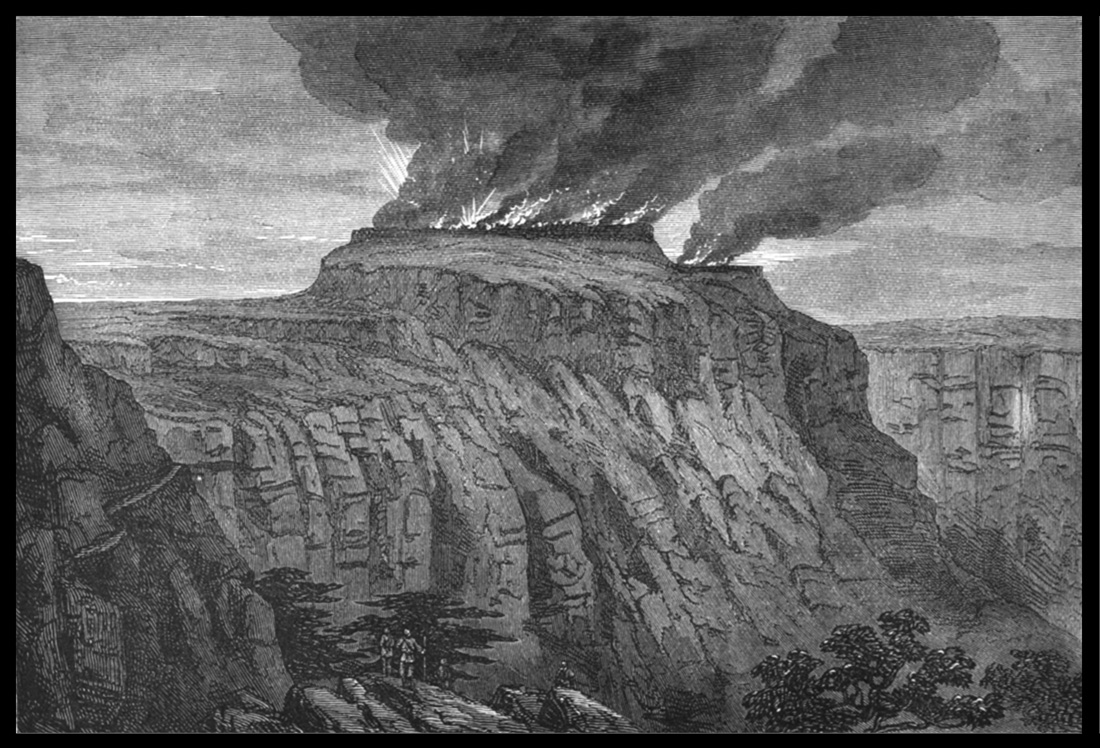
The Burning of Magdala, Tewedros' Mountain Fortress in 1868.
It shows Ethiopia as a country of high mountains and deep abysses.
Napier's 'Abyssinian Campaign': 1867
The British decided to invade Ethiopia to free the hostages. Under the leadership of Lieutenant-General Robert Napier, a first-rate engineer, the British Army had to overcome a series of technical challenges before it could march across the many obstacles in its way. Negotiations with the Egyptians and Ottomans gained the British a stretch of coast line on the Red Sea at Zula for use as its African logistics base. An EFFAPS (Ethiopian Field Force Army Postal Service) was set up under the auspices of the Indian Government in October 1867 for the benefit of the Anglo-Indian troops. As the Army moved toward Tewedros' mountain fortress capital of Magdala, 600 km away, Army Post Offices were established at Kumayler, SanCafe, Addigrat, Hentalo, also with each Brigade
Napier invading force comprised some 13,000 soldiers, mostly Indians, 26,000 camp followers and over 40,000 animals. (You would imagine a small but reasonable body of postal history emerging from this nine month campaign.) Napier soon found allies among the conquered Princes, many of whom had come out in active revolt against Tewedros whose Army disintegrated as Napier advanced. After the loyal remnant of his army was defeated with heavy casualties, Tewedros chose death before dishonour. Magdala, his fortress city, was burned and the hostages freed. Having no interest in Ethiopia, the British departed in June 1868, via Zula. The EFFAPS closed with no benefits accruing to the later Ethiopian postal system. From the ashes of Ethiopian defeat a more cohesive Ethiopian state arose.
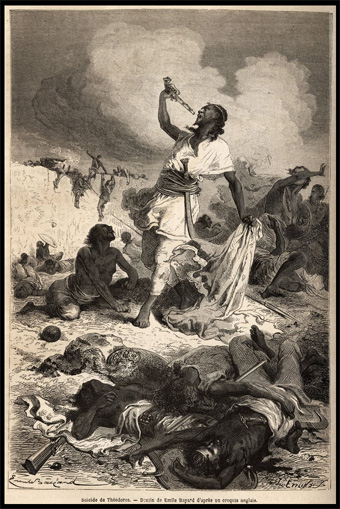
As the British storm his shattered fortress, Tewedros commits suicide with a pistol sent to him by Queen Victoria.
"I will rather put myself in the hands of God than in those of my enemies," he wrote.
He freed the hostages but had 300 traitors thrown off the parapets before he killed himself.
Following Tewedros' death and also that of his successor, Emperor John, in battle against Mahdists, the Khedivate of Egypt, an autonomous tributary state of the Ottoman Empire, and Italy were tempted to take control of some of the coastal regions, like the Ethiopian province of Harrar (Egypt. 1875) and Italian Eritrea (1882)and Somaliland (1889).
The first canceller used in Ethiopia
According to Adler, "the first postal system in Ethiopia was arranged by the British in Massawa on November 25th 1867 and lasted until June 1868." (Note: Zula is some 50km south of Massawa.) "During this time the stamps of India were used." Adler's statements raise a questions. If stamps were needed, which datestamp or canceller was used to obliterate them?
As Napier's Army was assembled in India with the agreement of the Indian government, it was very largely an Indian Field Force. It is appropriate then that "the stamps of India were used." But does this mean that an Indian Army Field Post Office datestamp or canceller was used and if so, which one? This would presumably be the first canceller used in Ethiopia.
Tewedros’ grandson, the King of Shewa (1866 to 1889), would ascend the ‘Throne of Solomon’ as Emperor Menelik II in 1889. A great moderniser, he introduced a postal system in 1895, later the telegraph, telephones, roads and railways. He initially enjoyed a good relationship with Italy who as a late participant in the European ‘Scramble for Africa’ desired a colonial African empire beyond its coastal possesions of Eritrea and Somaliland. Menelik wanted and got modern weapons. With them he won Ethiopia's and Africa's greatest victory over an invading Europeam army, the Italians at Adwa in 1896. Like the Sioux fighting the US 7th Cavalry at the Battle of the Little Big Horn twenty years earlier, Menelik's Ethiopian army fought an over-confident enemy while enjoying the benefit of more modern rifles and cannon. Penny-pinching Italian economics armed their soldiers with old rifles and sub-standard ammunition.
The Khedivate of Egypt's Invasion: 1875 - 1885
Napier’s success suggested to others - Egypt, Sudanese Mahdists and Italy - that Ethiopia was weak and vulnerable. After Tewedros' suicidePrince Gobaze became Emperor John of Ethiopia in 1872. He suppressed a rebellion and twice defeated an Egyptian Army intent on conquering Ethiopia in 1875 and 1876. His death from wounds received in a defeat by Sudanese Mahdists in 1889 gave the throne to Menelik II.
The second postal service to be run in Ethiopia was also the result of foreign invasion. Since the dawn of time, Egypt has wanted - and still wants - to expand southwards to take full control of the source of the Nile, its seasonal lifeblood. In 1874 the Khedivate of Egypt sensed a weakness in Ethiopia and decided to expand southwards at the expense of the Coptic Christian empire. Advancing from the Red Sea it occupied Harar province on Ethiopia's south-eastern flank. Today, Harar is today one of Ethiopia's main cities, but from 1875 - 1885, the independent Emirate of Harrar and the tribal area between it and the Somali port cities of Berbera and Zeila was under Egyptian occupation.
"A mute postmark in the design of a large Maltese cross"
According to Adler, "Reof Pascha .... built in 1876 a post office at Harrar in 1876. Until 1886 Egyptians used Egyptian stamps of 1867 - 1872 which were cancelled by a mute postmark in the design of a large Maltese cross".

The design of this 'Maltese Cross' appears to be more Ethiopian in style than Egyptian.
The faith of Islam is symbolized by the Crescent and Star. These are found in early Egyptian watermarks.
It is Adler who says that this is an 'Egyptian canceller', later an 'Egyptian postmarker'.
Much like a sophisticated cork canceller, this design is relatively easy to fabricate.
Why would the Egyptians who were predominantly Muslim use a Maltese Cross? This would be an anathema to them. Given the French postal presence in Egypt ever since Napoleon's Campaign, especially its post offices and postmarks it used there, the suggestion has been made that perhaps the Maltese Cross was a French device that somehow percolated down to the Khedivate of Egypt in Harrar. I can find no proof for this. Early French Egyptian postmarks are typical of European design of the time. This Maltese Cross is 'unique'.
As a result of these two invasions, the first two postmarks used in Ethiopia for postal purposes were British, probably Anglo-Indian. and Egyptian, not Ethiopian. It would be useful if someone could post an item from the British invasion of 1867 - 1868 so we can see what was used. When the Egyptians withdrew from Harrar in 1886, they left the mute Maltese Cross canceller in Harrar. This suggest they had no use for it in Egypt. Was it ever Egyptian? Was it not an ad hoc canceller made in Harrar by an Ethiopian for the Egyptians, the design of the cross being not-so-subtle comment that Egyptian Harrar was in reality Coptic Christian Ethiopia? Let's not forget that Egypt also had a large Coptic Christian minority. Perhaps this made the Maltese Cross canceller more acceptable?
Following the Egyptian withdrawal from Harrar in 1885, the expansionist Menelik II quickly absorbed his previously lost province and its Maltese Cross canceller back into his Empire. It would be at least ten years before the Maltese Cross canceller was used to cancel an Ethiopian stamp.
A mute postmark in the shape of a Maltese cross used in Addis Ababa in 1897.
Alfred Ilg was a Swiss engineer who been an advisor to Emperor Menelik II since he was King of Shoa. Not being French, British or Italian, the neutral non-colonialist Ilg was valued as a source of impartial advice and as a procurer of modern European weapons. In early 1892, Menelik accepted Ilg's suggestion that stamps be printed bearing his portrait. This rather put the cart before the horse as no Ethiopian Post Office existed at the time of Ilg's flattering suggestion.On 10th February 1893, Ilg received the news that he had probably been fishing for, namely that Menelik had granted him a concession to start a private Ethiopian postal system. As a result, in early in 1893 an order was placed with the world-famous French engraver Louis-Eugène Mouchon for a set of seven Ethiopian stamps.
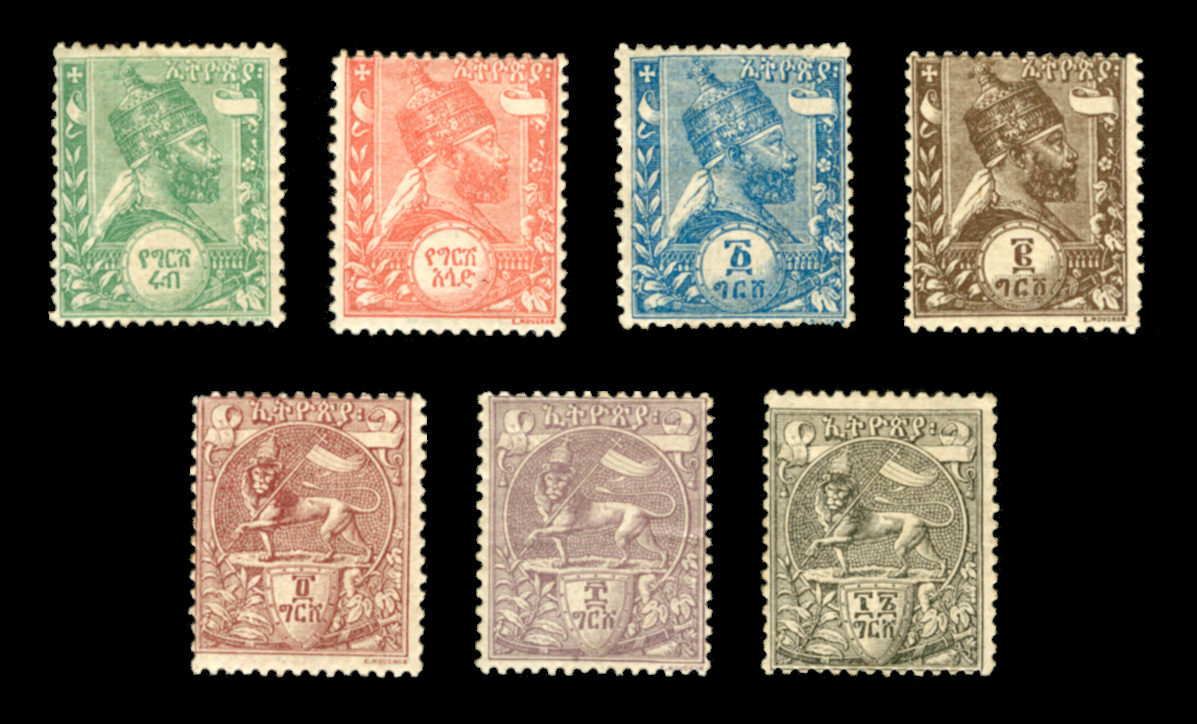
1894. The first set of seven Ethiopian stamps.
The values of ¼, ½, 1 and 2 guerch (g) showg portrait of Emperor Menelik II in profile.
The 4, 8, 16g values show the heraldic Lion of Judah.
The printer was Atelier du Timbre in Paris. They are neither common nor scarce.
After the strong box containing the Atelier du Timbre stamps, etc., arrived by camel caravan at the Ethiopian border it reached Harrar in July 1894 where it was deposited in the Franciscan Catholic mission. According to Adler, "the first postal experiments with the stamps started in Harrar in January 1895. Mr Gattiker, a brother of Mrs Ilg, arrived in Ethiopia from Europe in June 1895." He bought with him to the Cathloic mission two cancellers. According to Adler these were "a canceller with European and Amharic lettering and Amharic date, and a similar one but with date in European type". According to Ulf Lindahl, the first postmarks looked like these below. They are taken from his Gold Medal winning 'Early Ethiopia 1895 - 1913' display. Lindahl's examples shown below show two, not one, "canceller(s) with European and Amharic lettering and Amharic date", as Adler attributes to Mr Gattiker.

The postmark below fits Adler description of "a canceller with European and Amharic lettering .... and a similar one but with date in European type." However, given the postmark above, one assumes (!) that the one below should perhaps be in the same style of design ie. the inner circle divided in three to accomodate a European / Arabic date format.

1897. Early-ish examples from Harrar ex-Ulf Lindahl's Gold Medal winning 'Early Ethiopia 1895 - 1913' display.
Readers interested in Ethiopian Postal History absolutely must view it.
Search for the Ethiopian Philatelic Society to see it displayed in all its glory.
I have tried to make a link but it keeps timing out.
Until the postal system came under Ethiopian management, Adler says “postal tasks were entrusted to the priests .... at Harrar”. He adds that “the Egyptian postmarker was used .... for cancelling stamps on private letters .... by these priests.” Presumably, this "Egyptian postmarker" refers to Harrar's old Khedivate of Egypt mute Maltese Cross canceller, not Gattiker's European-made ones? Unfortunately for Ethiopia and its nascent postal system the Italians now invaded their country. The new post office was subordinated to the exigencies of the war. Only after its conclusion following Italian defeat at Adwa in March 1896 did the post office resume service.
Ulf Lindahl's Gold Medal winning 'Early Ethiopia 1895 - 1913' display shows a wonderful postcard on a sheet headed 'Emergency Use of Maltese Cross in Addis Ababa, January - March 1897'. This has a 1 guerche blue Menelik II portrait stamp cancelled with a Maltese Cross in Addis Ababa, manuscript dated February 24 1897. Lindahl says "Entotto's first canceller was lost at the end of 1896; a mute "Maltese Cross" was used instead for three months to cancel the mail in Addis Ababa until the Entotto canceller (delivered in 1896) began to be used in April 1897".
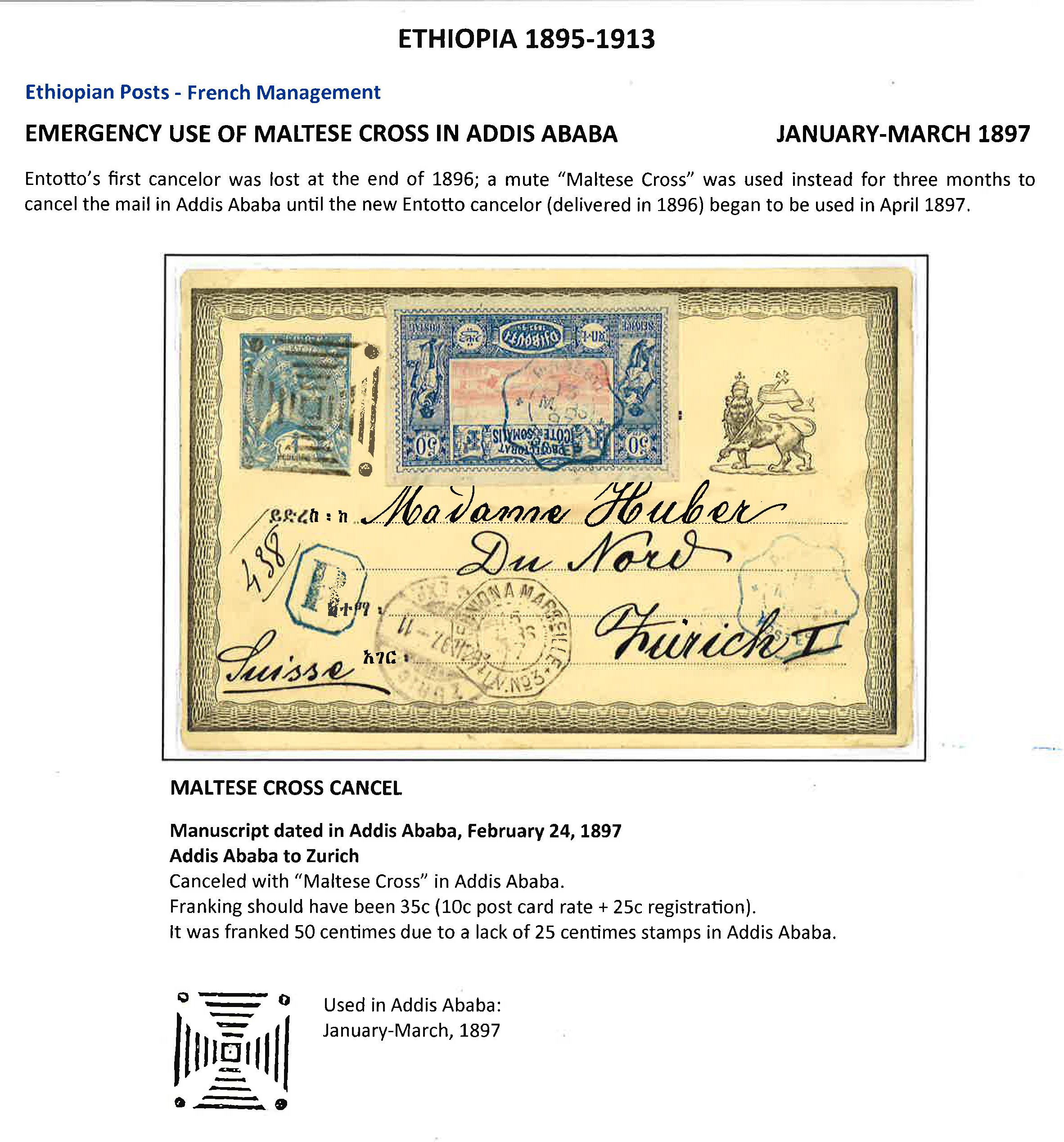
Is this the same Maltese Cross canceller used in Harrar by the Khedivate of Egypt and the Catholic Mission? If so, the above is an example of one of the first two foreign cancellers used in Ethiopia before the start of its postal system.
However, its date of use in Entotto precedes the Catholic mission's return of the strong box almost three years later. Adler tells us that after three Swiss postal officials arrived in Ethiopia to better organise its post office, the Catholic mission in Harrar handed over its stock of stamps in late 1899 / early 1900 on the request of Swiss postal official, Herr Wullschleger. The mission provided him with:
899 of each sheet from ¼ to 16g in value, a total of 6293 sheets,
(this number included the 100 sheets sent to Gattiker in January 1895),
a wrapper containing the original 200 ‘provincial blocks’,
a canceller without any date, (the Maltese Cross),
a HARRAR canceller with Amharic date, and a
canceller with a European date, (presumably also HARRAR).
This tells us that 'a canceller without any date' (presumably the Maltese Cross?) was in Harrar in late 1899 / early 1900. Had it been in Harrar all along or was it returned to Harrar after it was used in Entotto as a temporary replacement canceller in 1897. Are they different or the same?
However, it could be that it did go to Entotto as a temporary replacement canceller. At this time the Catholic Mission was having its postal activities cut back as Ilg's postal service took root. They may not have had a need for it. If it is true they had little or no use for it, why was it returned to be listed in Herr Wullschleger's stock-taking? A third explanation is that the description "a canceller without a date," refers to another canceller altogether and that the idea this is Adler's "Maltese Cross" is wishful thinking on his part.
So, if this canceller is not the Egyptian Harrar canceller, what is it? Some expert advice would be appreciated!
Anyone interested in Ulf Lindahl's magnicent Gold Medal winning 'Early Ethiopia 1895 - 1913' display should search for the Ethiopian Philatelic Society where it is displayed in all its glory. I have tried to make a link but it keeps timing out.
Quote from Steve on February 11, 2024, 12:21 pmAlfred Ilg and the Modernisation and Development of Ethiopia in tbe late 19th Century.
Alfred Ilg, (right), was a Swiss engineer who came from a poor and humble background. However, he had the great good fortune to be born in Switzerland in 1854, a country where if you had intelligence and the desire for an education it was not withheld from you, generally unlike Britain. Ilg initially trained as a mechanic but through dint of perserverance and determination he qualified as an engineer at the Federal Institute of Technology in Zürich. After qualifying his desire was to travel and work in a foreign country.
Ilg applied for and found employment with the King of Shewa, later Emperor Menelik II. After a long and difficult six month journey he arrived at the court of the King of Shewa in Ethiopia by camel in January 1879. In selecting Ilg, the King had been careful to find a man who was not a subject or a citizen of Britain, France or Italy, the major imperialist regional powers bordering on Ethiopia, the ones most likely to pose an aggressive threat to Ethiopian independence. As a neutral non-colonialist, Ilg became a valued source of impartial political advice to the King of Shewa and, not least, a vital source for the procurement of modern European weapons.
In 1889, the King of Shewa became Emperor Menelik II and Ilg's star rose in the ascendant, not only as an engineer but also as a valued courtier. In early 1892, Menelik accepted Ilg's suggestion that stamps bearing his portrait be printed. This rather put the cart before the horse as no Ethiopian Post Office existed at the time of Ilg's flattering suggestion. Unsurprisingly on 10th February 1893, Ilg received the news that he had probably been fishing for, namely that Menelik had granted him a concession to start a private Ethiopian postal system. At the same time he was instructed build a railway line, a telegraph and a telephone system, both of which would need electicity.
Cover. ADDIS ABABA (ENTOTTO) 'Date faint - May 29 (?) 1895' to ZURICH '9 JUL 95'.
Djibouti June 14; Obock June 16; then Aden to Brindisi; Paris July 8; Zurch July 9.
This is the only known cover from the first lot of Ethiopian mail dispatched from Addis Ababa.
Sent by the Empress Taitu (Seal on reverse) to Alfred IlgThis wonderful item is in the collection of Ulf Lindahl.
Search for the Ethiopian Philatelic Society to see it displayed in all its glory.
I have tried to make a link but it keeps timing out.Ilg showed his competence as an engineer when planning and implementing the railway line from Djibouti to the Dire Dawa. Additionally, Ilg was also responsible for supervising the design and construction of the first piped water supply to the capital and for installing electrical power in the imperial palace in 1905. He was in charge of the construction of several public buildings and worked as chef de protcolle and secretary for the emperor, receiving the highest medal available, the Star of Ethiopia. Menelik II rewarded Ilg, making him a ‘Counselor in the range of an Excellency’ in 1897 and, additionally, making him Foreign Minister for the next ten years.
A Share Certificate for the Imperial Ethiopian Railway Company signed by Alfred Ilg.
However, following a growth in French influence in Ethiopia, a German delegation arrived under the command of Friedrich Rosen, an orientalist. Several treaties were signed between Ethiopia and Germany in March 1905, Ilg's influence at court began to wane. Unwilling to be dragged into the Byzantine intrigues that pre-occupied the court of Menelik II, Ilg resigned in 1907 and returned to Europe. He died in Zürich aged 61. His legacy was the modernisation of almost every part of Ethiopia's previously medieval systems and structures.
Alfred Ilg and the Modernisation and Development of Ethiopia in tbe late 19th Century.
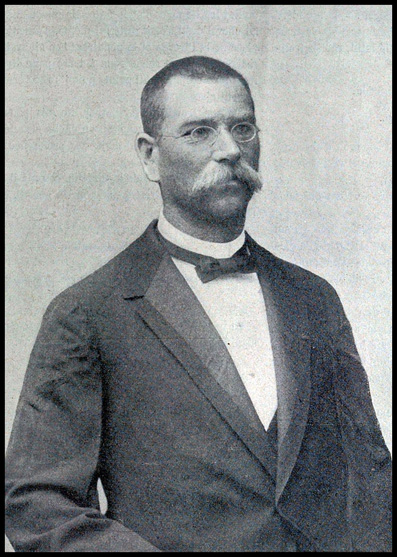
Alfred Ilg, (right), was a Swiss engineer who came from a poor and humble background. However, he had the great good fortune to be born in Switzerland in 1854, a country where if you had intelligence and the desire for an education it was not withheld from you, generally unlike Britain. Ilg initially trained as a mechanic but through dint of perserverance and determination he qualified as an engineer at the Federal Institute of Technology in Zürich. After qualifying his desire was to travel and work in a foreign country.
Ilg applied for and found employment with the King of Shewa, later Emperor Menelik II. After a long and difficult six month journey he arrived at the court of the King of Shewa in Ethiopia by camel in January 1879. In selecting Ilg, the King had been careful to find a man who was not a subject or a citizen of Britain, France or Italy, the major imperialist regional powers bordering on Ethiopia, the ones most likely to pose an aggressive threat to Ethiopian independence. As a neutral non-colonialist, Ilg became a valued source of impartial political advice to the King of Shewa and, not least, a vital source for the procurement of modern European weapons.
In 1889, the King of Shewa became Emperor Menelik II and Ilg's star rose in the ascendant, not only as an engineer but also as a valued courtier. In early 1892, Menelik accepted Ilg's suggestion that stamps bearing his portrait be printed. This rather put the cart before the horse as no Ethiopian Post Office existed at the time of Ilg's flattering suggestion. Unsurprisingly on 10th February 1893, Ilg received the news that he had probably been fishing for, namely that Menelik had granted him a concession to start a private Ethiopian postal system. At the same time he was instructed build a railway line, a telegraph and a telephone system, both of which would need electicity.
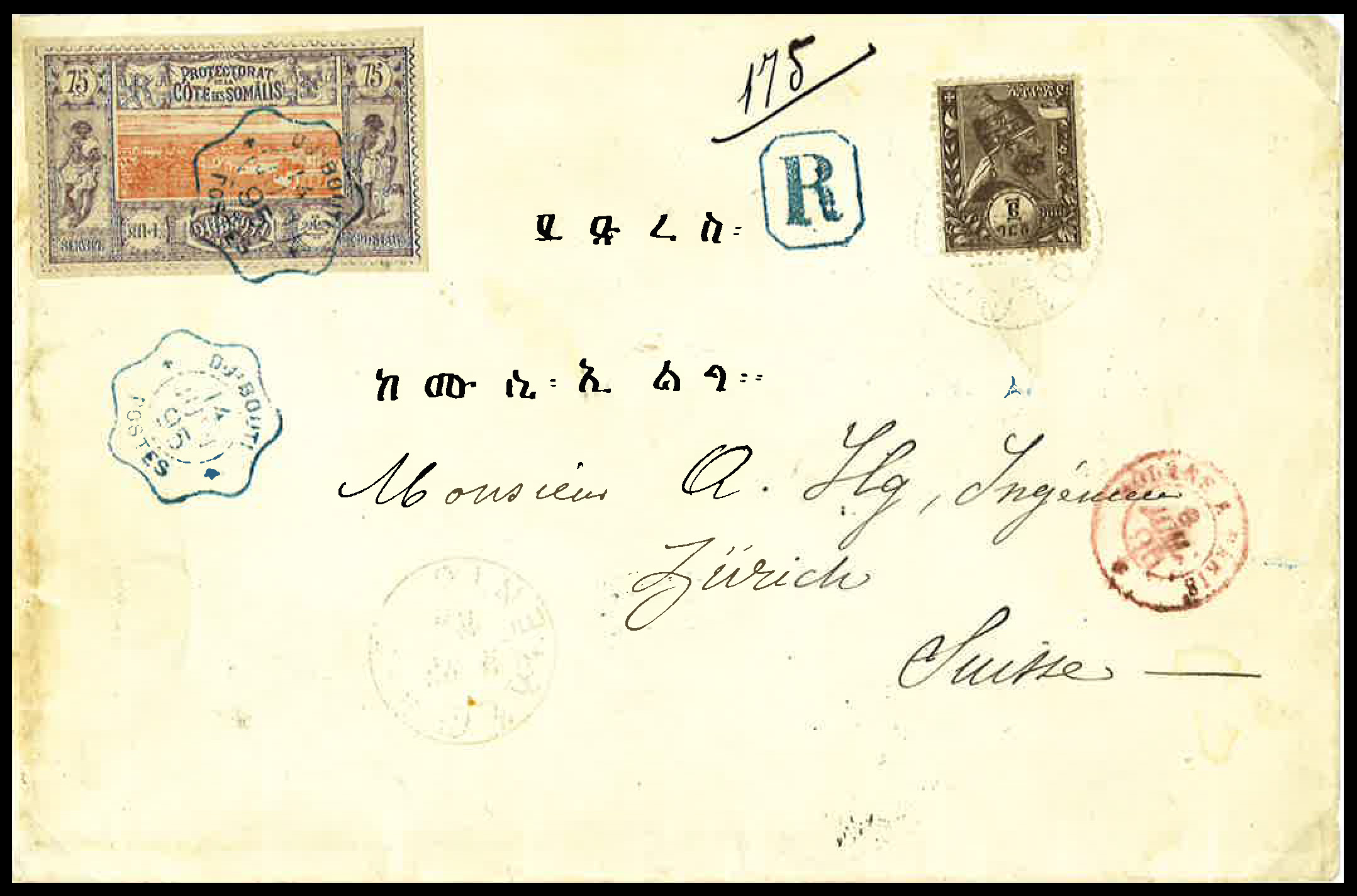
Cover. ADDIS ABABA (ENTOTTO) 'Date faint - May 29 (?) 1895' to ZURICH '9 JUL 95'.
Djibouti June 14; Obock June 16; then Aden to Brindisi; Paris July 8; Zurch July 9.
This is the only known cover from the first lot of Ethiopian mail dispatched from Addis Ababa.
Sent by the Empress Taitu (Seal on reverse) to Alfred Ilg
This wonderful item is in the collection of Ulf Lindahl.
Search for the Ethiopian Philatelic Society to see it displayed in all its glory.
I have tried to make a link but it keeps timing out.
Ilg showed his competence as an engineer when planning and implementing the railway line from Djibouti to the Dire Dawa. Additionally, Ilg was also responsible for supervising the design and construction of the first piped water supply to the capital and for installing electrical power in the imperial palace in 1905. He was in charge of the construction of several public buildings and worked as chef de protcolle and secretary for the emperor, receiving the highest medal available, the Star of Ethiopia. Menelik II rewarded Ilg, making him a ‘Counselor in the range of an Excellency’ in 1897 and, additionally, making him Foreign Minister for the next ten years.
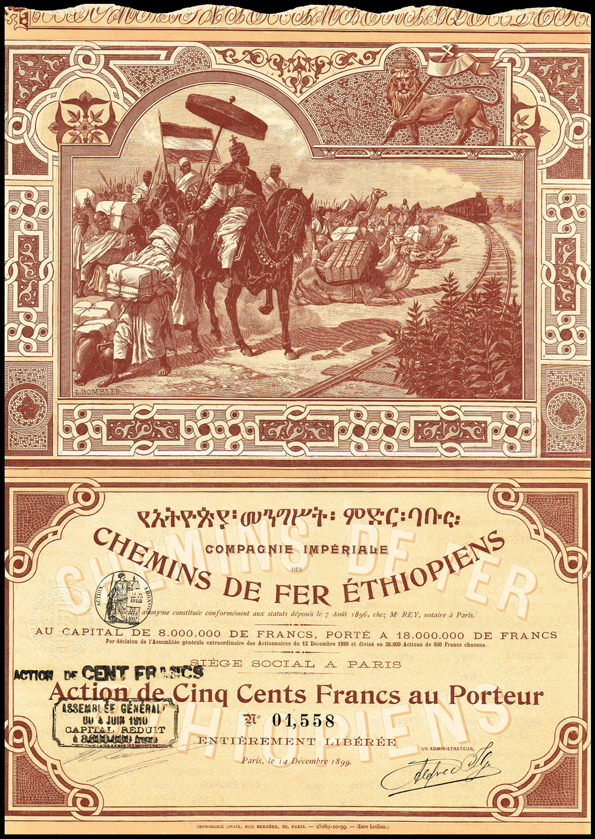
A Share Certificate for the Imperial Ethiopian Railway Company signed by Alfred Ilg.
However, following a growth in French influence in Ethiopia, a German delegation arrived under the command of Friedrich Rosen, an orientalist. Several treaties were signed between Ethiopia and Germany in March 1905, Ilg's influence at court began to wane. Unwilling to be dragged into the Byzantine intrigues that pre-occupied the court of Menelik II, Ilg resigned in 1907 and returned to Europe. He died in Zürich aged 61. His legacy was the modernisation of almost every part of Ethiopia's previously medieval systems and structures.
Quote from Steve on February 13, 2024, 12:39 pmThe First Ethiopia Stamp issue: 1894/95 - 1901.
On 10th February 1893 Menelik when awarded Albert Ilg a concession to set up a Ethiopian Postal Service. As a result, in early in 1893 an order was placed with the famous French engraver Louis-Eugène Mouchon for a set of stamps comprising seven values:
- The name of the country in Amharic is 'ITYOPIYA'.
- ¼, ½, 1 and 2 guerch (g) with the portrait of Emperor Menelik II in profile,
- 4, 8, 16g values showing the heraldic Lion of Judah.
- The printer was Atelier du Timbre in Paris.
1894. The first set of seven Ethiopian stamps. Mint.
Stanley Gibbons describes the Menelik II colours as (LTR) green, red, blue and brown. SG 1 - 4.
It describes the Lion of Judah colours as (LTR) red, mauve and black. SG 5 - 7.But that is not all that was printed! In Doig's Ethiopia Catalogue, Lindahl tells us that "The three high values in the first (1894) set, (4, 8 & 16 guerches), were also printed with Menelik II's portait but were not issued" ie. the values shown above on the Lion of Judah stamps were also printed on Menelik portraits. He continues. "In 1896 the seven Menelik II portait vales were converted to Postage Dues with an overprint which read 'ASKEFIL', (Amharic. Let him pay'). These Postage Dues were never issued or used in Ethiopia."
A strong box containing 6300 sheets, (150 stamps each, some 950,000 in total), of all seven values, along with 3,000 postcards of ¼,½ and 1g were despatched to the Ethiopian Consul in Djibouti in the French Somali Coast, in December 1893. The box also included 200 blocks of four imperforate 1g ‘province’ stamps with the names of Shoa, Harrar, Kaffa and Tigre imprinted in Amharic in the top right scroll of the stamp. Scarce then, these are rare today. A second printing with the provinces of Godjam, Sidamo, Wallaga and Jimma was made but never used.
- In Paris, 7000 sheets of this first Ethiopian stamp issue were retained, (presumably 1000 sheets of each value).
- Some of these would be sold to European collectors and visitors to the Paris Exposition.
- Many would return via the back-door to Ethiopia to utterly undermine is nascent Post Office.
- Others would fall into the hands of the unscrupulous and have faked overprints applied to them.
- The collection of first issue of Menelik II with overprints is a painstaking exercise in determining fakes.
- So great was the fakery that their collection is a subject in itself!
It is very likely that most, if not all, of the mint stamps shown in this display are of French, not Ethiopian origin.
Stanley Gibbons dates this issue as 1894, the year of its printing. However, it was not issued in Ethiopia until 1895.
Establishment of the Ethiopian Postal System.
On 9th March 1894 the Ethiopian postal system was established by Imperial decree. That same day, Alfred Ilg was also instructed to start a railway, a telegraph and a telephone system.
The strong box containing the Atelier du Timbre first issue stamps, etc., arrived by camel caravan at the Ethiopian border it reached Harrar in July 1894 where it was deposited in the Franciscan Catholic mission. Until the postal system came under Ethiopian management, Adler says “postal tasks were entrusted to the priests .... at Harrar”. He adds that “the Egyptian postmarker was used .... for cancelling stamps on private letters .... by these priests.” (Presumably, this refers to the old Egyptian Maltese Cross canceller?)
In January 1895 Ilg’s brother-in-law, a Mr Gattiker, arrived in Harrar’s from Europe. He brought to the Catholic mission two datestamps, both with European and Amharic lettering, one with an Amharic date, the other with a European date. According to Adler “the first postal experiments with the sale of stamps started at Harrar in January 1895”. He also states that “100 sheets .... had been sent to Gattiker”. These came from the strongbox in the Catholic mission. Thus began the Ethiopian postal system in the old provincial capital of Harrar under the management of a Swiss postmaster using bilingual datestamps. The plan was for post offices to be organised town by town and eventually spread out to include the remoter country areas. However, war with Italy delayed these plans.
Foreign Post Offices in Ethiopia
The war with Italy delayed what was already a slow start to the Ethopian postal services.
Albert Ilg feared the establishment of foreign post offices in Ethiopia, specifically French ones. The French had opened post offices in Addis Ababa, Harrar and Dire Daoua. From 1898 the French legation possessed and used cancellers inscribed ‘POSTES FRANCAIS / ADDIS ABABA’ and or ‘POSTES FRANCAIS / DIRE DAOUA. At Ilg’s request three Swiss postal officials arrived in Ethiopia to assist in the organisation of regular postal distribution on 22nd August 1899. After the arrival of the Swiss postal officials the use of these French cancellers were no longer used. The cancellers were later used with the word ‘FRANCAIS’ removed.
One of the Swiss postal officials died of sunstroke shortly after arriving and in December 1899 another was assassinated. After this date the Catholic mission in Harrar was prohibited from carrying the courier bags of the French legation. Similarly, it and the French vice-consul in Harrar was prohibited from receiving mail for forwarding to Europe. “Although some cancellation may probably indicate the contrary,” says Adler, “the French post offices of Addis Ababa, Harrar, and Dire Daoua were no longer of importance to the postal services of Ethiopia”. This suggests that by exerting some control over rival postal systems Ilg had managed to position the nascent Ethiopian postal system as a viable alternative.
Start of the Post Office in Ethiopia.
Adler states that when the Catholic mission in Harrar handed over its stock of stamps in late 1899 / early 1900 at the request of a Swiss postal official, Herr Wullschleger, the mission provided him with:
- 899 of each sheet from ¼ to 16g in value, a total of 6293 sheets,
- (this number included the 100 sheets sent to Gattiker in January 1895),
- a wrapper containing the original 200 ‘provincial blocks’,
- a canceller without a date, (presumably the Egyptian Maltese Cross),
- a HARRAR canceller with Amharic date, and a
- canceller with a European date, (presumably also HARRAR).
This shows that between July 1894 when the mission in Harrar received the strongbox containing 6300 sheets and early 1900 no stamps were used by the Catholic mission or by others except for the 100 sheets supplied to Gattiker. The shortfall of seven sheets of 150 stamps, 1050 in total, was a commission of 150 complete sets given to the Catholic mission, presumably for services rendered. This suggests, somewhat confusingly, that the bulk of the first issue stamps were not sold in Ethiopian post offices until early 1900.
With the war over - the peace saw Italy recognise Ethiopia’s independence - Ilg resumed his various jobs of work, organising the start of the postal , telegraph and telephone systems, and not least, the Ethiopian railway system. Unsurprisingly, none of these ventures grew with any rapidity. As the railway line from Djibouto to Addis Ababa developed the completed part of the line was used to transport postal bags. The receipt and despatch of these bags was through the Catholic mission in Harrar until 1904 when the railway reached Dire Dawa where a post office was opened. (See map showing 'Post Routes in Ethiopia in 1904.... below).
Copyright. ‘Handbook of the Postage Stamps of the Empire of Ethiopia and Her Postal System’.
(Ivan Adler, Knight of the Star Order of Ethiopia, Stockhom, Sweden. 1961.)Arthur Maury and the Exposition Universelle, Paris: 1900
The 1900 Paris Exposition was a long-running World Fair held in the French capital from 14th April to 12th November 1900. It’s aim was to to celebrate the achievements of the past 19th Century while embracing and celebrating the potential of the looming 20th Century. Many technological innovations were there to be marvelled at. Emperor Menelik was eager that Ethiopia be represented as a strong and technically competent emerging African nation. According to Adler, “the stamps of the first issue of Ethiopia were sold in the Ethiopian pavillion in order to provide propaganda for Ethiopia and its newly started post and railway”.
Fin de siècle Paris in all it Aristic Glory. 1900.("Forgive me fellow philatalistes ..... it is the absinthe talking!").When the Exposition ended, Leon Chefneux, Ilg’s partner, entrusted the remaining stamps in Paris to Arthur Maury, an amiable leading French philatelist and author who was also a stamp dealer and a forger with 'a face like Father Christmas'. In 1865 Maury had made a name for himself by publishing the first edition of a comprehensive stamp catalogue which became the standard for collectors and dealers. This catalogue offered his ‘space-filler’ reprints and imitations of United States local issues. Later he grew bolder, supplying his own bogus provisional Diego-Suarez overprints and the postage due stamps of Persia.
Maury had been involved in the printing of the first issue of Ethiopia in 1894 (issued in 1895). In 1896 he made available to collectors an unauthorized postage due overprint that was never used in Ethiopia.
Fakers, Forgers, Fraudsters and Charlatans
1896. Postage Due stamps never issued or used in Ethiopia.
Date of official issue reported by Maury as February, 1896. Forgery sale date October, 1896.Lindahl (Doig's Ethiopia Catalogue) tells us that "The three high values in the first (1894) set, (4, 8 & 16 guerches), were also printed with Menelik II's portait but were not issued. In 1896 the seven Menelik II portait vales were converted to Postage Dues with an overprint which read 'ASKEFIL', (Amharic. Let him pay'). These Postage Dues were never issued or used in Ethiopia."
Lindahl's explanation explains why the colours above are NOT consistent with the first issue. Because they were never issued or used, Stanley Gibbons does not include these Postage Dues in mauve and black, as seen in the lower value Menelik II portrait stamps above.
Mercier and Fournier both produced forged stamps with fake ASKEFIL (Amharic. Let him pay) overprint. Curiously, Louis-Henri Mercier, (real name Henri Goegg), produced a poor quality 'facsimile' which he cancelled with a Maltese Cross! Francois Fournier also produced 'facsimiles' of the 1894 issue, including Maury's 1896 Postage Due, and most of the overprints and cancels through 1908.
After the Paris Exposition concluded in November 1900, Maury began to sell the remaining sets from the first Ethiopian issue for 1.50 francs each, just one third of the value of the stamps in Ethiopia. This led to many of these stamps being purchased in France and resold on the black market in Ethiopia at a profit. The led to a decrease in the sale of stamps in Ethiopia at just the time when its mail volumes were increasing and reduced its post office's slender profitability.
Something had to be done to safeguard its revenues. In order to avoid further future financial loss by the Ethiopian post office, the Emperor issued an edict on 18th July 1901 declaring that the old, first issue stamps of 1894 were no longer valid without an overprinted control. A direct consequence of Maury’s stamp sales led to Ethiopian stamps being overprinted annually between 1901 to 1907.
In the next post I will cover the various overprints made between 1901 and 1907.
The First Ethiopia Stamp issue: 1894/95 - 1901.
On 10th February 1893 Menelik when awarded Albert Ilg a concession to set up a Ethiopian Postal Service. As a result, in early in 1893 an order was placed with the famous French engraver Louis-Eugène Mouchon for a set of stamps comprising seven values:
- The name of the country in Amharic is 'ITYOPIYA'.
- ¼, ½, 1 and 2 guerch (g) with the portrait of Emperor Menelik II in profile,
- 4, 8, 16g values showing the heraldic Lion of Judah.
- The printer was Atelier du Timbre in Paris.

1894. The first set of seven Ethiopian stamps. Mint.
Stanley Gibbons describes the Menelik II colours as (LTR) green, red, blue and brown. SG 1 - 4.
It describes the Lion of Judah colours as (LTR) red, mauve and black. SG 5 - 7.
But that is not all that was printed! In Doig's Ethiopia Catalogue, Lindahl tells us that "The three high values in the first (1894) set, (4, 8 & 16 guerches), were also printed with Menelik II's portait but were not issued" ie. the values shown above on the Lion of Judah stamps were also printed on Menelik portraits. He continues. "In 1896 the seven Menelik II portait vales were converted to Postage Dues with an overprint which read 'ASKEFIL', (Amharic. Let him pay'). These Postage Dues were never issued or used in Ethiopia."
A strong box containing 6300 sheets, (150 stamps each, some 950,000 in total), of all seven values, along with 3,000 postcards of ¼,½ and 1g were despatched to the Ethiopian Consul in Djibouti in the French Somali Coast, in December 1893. The box also included 200 blocks of four imperforate 1g ‘province’ stamps with the names of Shoa, Harrar, Kaffa and Tigre imprinted in Amharic in the top right scroll of the stamp. Scarce then, these are rare today. A second printing with the provinces of Godjam, Sidamo, Wallaga and Jimma was made but never used.
- In Paris, 7000 sheets of this first Ethiopian stamp issue were retained, (presumably 1000 sheets of each value).
- Some of these would be sold to European collectors and visitors to the Paris Exposition.
- Many would return via the back-door to Ethiopia to utterly undermine is nascent Post Office.
- Others would fall into the hands of the unscrupulous and have faked overprints applied to them.
- The collection of first issue of Menelik II with overprints is a painstaking exercise in determining fakes.
- So great was the fakery that their collection is a subject in itself!
It is very likely that most, if not all, of the mint stamps shown in this display are of French, not Ethiopian origin.
Stanley Gibbons dates this issue as 1894, the year of its printing. However, it was not issued in Ethiopia until 1895.
Establishment of the Ethiopian Postal System.
On 9th March 1894 the Ethiopian postal system was established by Imperial decree. That same day, Alfred Ilg was also instructed to start a railway, a telegraph and a telephone system.
The strong box containing the Atelier du Timbre first issue stamps, etc., arrived by camel caravan at the Ethiopian border it reached Harrar in July 1894 where it was deposited in the Franciscan Catholic mission. Until the postal system came under Ethiopian management, Adler says “postal tasks were entrusted to the priests .... at Harrar”. He adds that “the Egyptian postmarker was used .... for cancelling stamps on private letters .... by these priests.” (Presumably, this refers to the old Egyptian Maltese Cross canceller?)
In January 1895 Ilg’s brother-in-law, a Mr Gattiker, arrived in Harrar’s from Europe. He brought to the Catholic mission two datestamps, both with European and Amharic lettering, one with an Amharic date, the other with a European date. According to Adler “the first postal experiments with the sale of stamps started at Harrar in January 1895”. He also states that “100 sheets .... had been sent to Gattiker”. These came from the strongbox in the Catholic mission. Thus began the Ethiopian postal system in the old provincial capital of Harrar under the management of a Swiss postmaster using bilingual datestamps. The plan was for post offices to be organised town by town and eventually spread out to include the remoter country areas. However, war with Italy delayed these plans.
Foreign Post Offices in Ethiopia
The war with Italy delayed what was already a slow start to the Ethopian postal services.
Albert Ilg feared the establishment of foreign post offices in Ethiopia, specifically French ones. The French had opened post offices in Addis Ababa, Harrar and Dire Daoua. From 1898 the French legation possessed and used cancellers inscribed ‘POSTES FRANCAIS / ADDIS ABABA’ and or ‘POSTES FRANCAIS / DIRE DAOUA. At Ilg’s request three Swiss postal officials arrived in Ethiopia to assist in the organisation of regular postal distribution on 22nd August 1899. After the arrival of the Swiss postal officials the use of these French cancellers were no longer used. The cancellers were later used with the word ‘FRANCAIS’ removed.
One of the Swiss postal officials died of sunstroke shortly after arriving and in December 1899 another was assassinated. After this date the Catholic mission in Harrar was prohibited from carrying the courier bags of the French legation. Similarly, it and the French vice-consul in Harrar was prohibited from receiving mail for forwarding to Europe. “Although some cancellation may probably indicate the contrary,” says Adler, “the French post offices of Addis Ababa, Harrar, and Dire Daoua were no longer of importance to the postal services of Ethiopia”. This suggests that by exerting some control over rival postal systems Ilg had managed to position the nascent Ethiopian postal system as a viable alternative.
Start of the Post Office in Ethiopia.
Adler states that when the Catholic mission in Harrar handed over its stock of stamps in late 1899 / early 1900 at the request of a Swiss postal official, Herr Wullschleger, the mission provided him with:
- 899 of each sheet from ¼ to 16g in value, a total of 6293 sheets,
- (this number included the 100 sheets sent to Gattiker in January 1895),
- a wrapper containing the original 200 ‘provincial blocks’,
- a canceller without a date, (presumably the Egyptian Maltese Cross),
- a HARRAR canceller with Amharic date, and a
- canceller with a European date, (presumably also HARRAR).
This shows that between July 1894 when the mission in Harrar received the strongbox containing 6300 sheets and early 1900 no stamps were used by the Catholic mission or by others except for the 100 sheets supplied to Gattiker. The shortfall of seven sheets of 150 stamps, 1050 in total, was a commission of 150 complete sets given to the Catholic mission, presumably for services rendered. This suggests, somewhat confusingly, that the bulk of the first issue stamps were not sold in Ethiopian post offices until early 1900.
With the war over - the peace saw Italy recognise Ethiopia’s independence - Ilg resumed his various jobs of work, organising the start of the postal , telegraph and telephone systems, and not least, the Ethiopian railway system. Unsurprisingly, none of these ventures grew with any rapidity. As the railway line from Djibouto to Addis Ababa developed the completed part of the line was used to transport postal bags. The receipt and despatch of these bags was through the Catholic mission in Harrar until 1904 when the railway reached Dire Dawa where a post office was opened. (See map showing 'Post Routes in Ethiopia in 1904.... below).
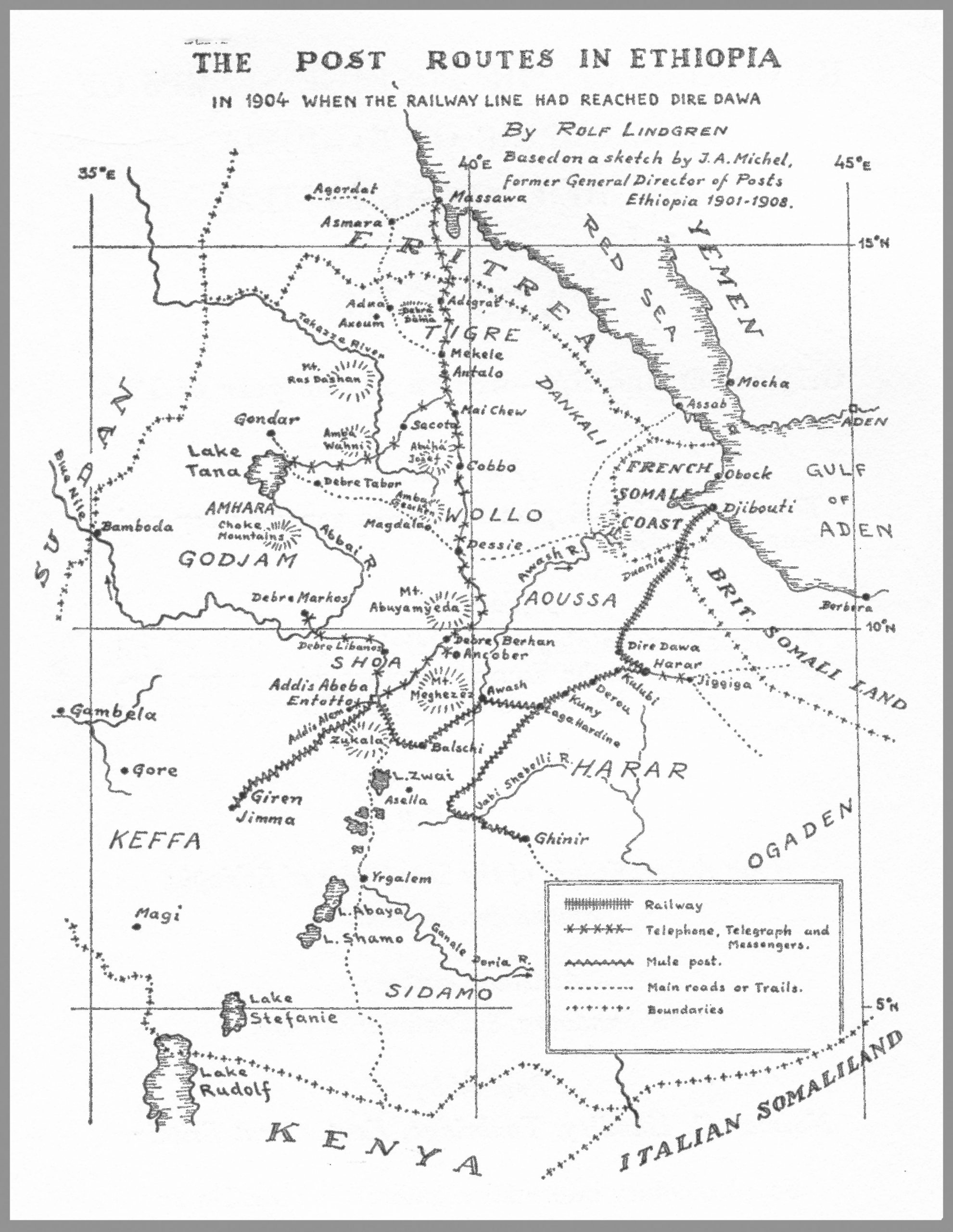
Copyright. ‘Handbook of the Postage Stamps of the Empire of Ethiopia and Her Postal System’.
(Ivan Adler, Knight of the Star Order of Ethiopia, Stockhom, Sweden. 1961.)
Arthur Maury and the Exposition Universelle, Paris: 1900
The 1900 Paris Exposition was a long-running World Fair held in the French capital from 14th April to 12th November 1900. It’s aim was to to celebrate the achievements of the past 19th Century while embracing and celebrating the potential of the looming 20th Century. Many technological innovations were there to be marvelled at. Emperor Menelik was eager that Ethiopia be represented as a strong and technically competent emerging African nation. According to Adler, “the stamps of the first issue of Ethiopia were sold in the Ethiopian pavillion in order to provide propaganda for Ethiopia and its newly started post and railway”.
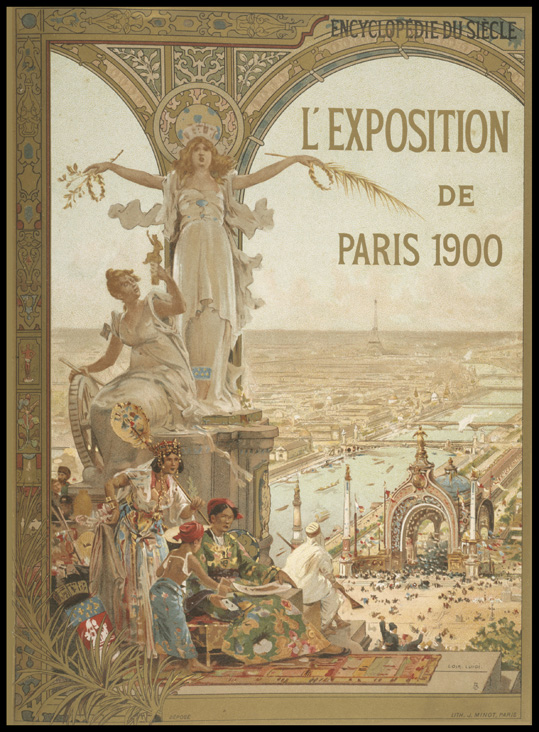
When the Exposition ended, Leon Chefneux, Ilg’s partner, entrusted the remaining stamps in Paris to Arthur Maury, an amiable leading French philatelist and author who was also a stamp dealer and a forger with 'a face like Father Christmas'. In 1865 Maury had made a name for himself by publishing the first edition of a comprehensive stamp catalogue which became the standard for collectors and dealers. This catalogue offered his ‘space-filler’ reprints and imitations of United States local issues. Later he grew bolder, supplying his own bogus provisional Diego-Suarez overprints and the postage due stamps of Persia.
Maury had been involved in the printing of the first issue of Ethiopia in 1894 (issued in 1895). In 1896 he made available to collectors an unauthorized postage due overprint that was never used in Ethiopia.
Fakers, Forgers, Fraudsters and Charlatans
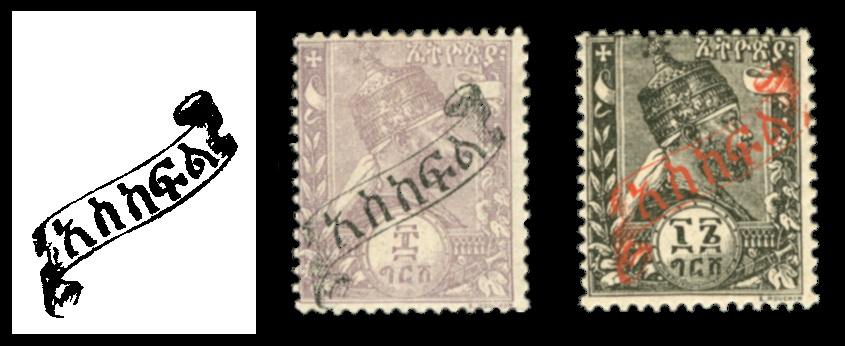
1896. Postage Due stamps never issued or used in Ethiopia.
Date of official issue reported by Maury as February, 1896. Forgery sale date October, 1896.
Lindahl (Doig's Ethiopia Catalogue) tells us that "The three high values in the first (1894) set, (4, 8 & 16 guerches), were also printed with Menelik II's portait but were not issued. In 1896 the seven Menelik II portait vales were converted to Postage Dues with an overprint which read 'ASKEFIL', (Amharic. Let him pay'). These Postage Dues were never issued or used in Ethiopia."
Lindahl's explanation explains why the colours above are NOT consistent with the first issue. Because they were never issued or used, Stanley Gibbons does not include these Postage Dues in mauve and black, as seen in the lower value Menelik II portrait stamps above.
Mercier and Fournier both produced forged stamps with fake ASKEFIL (Amharic. Let him pay) overprint. Curiously, Louis-Henri Mercier, (real name Henri Goegg), produced a poor quality 'facsimile' which he cancelled with a Maltese Cross! Francois Fournier also produced 'facsimiles' of the 1894 issue, including Maury's 1896 Postage Due, and most of the overprints and cancels through 1908.
After the Paris Exposition concluded in November 1900, Maury began to sell the remaining sets from the first Ethiopian issue for 1.50 francs each, just one third of the value of the stamps in Ethiopia. This led to many of these stamps being purchased in France and resold on the black market in Ethiopia at a profit. The led to a decrease in the sale of stamps in Ethiopia at just the time when its mail volumes were increasing and reduced its post office's slender profitability.
Something had to be done to safeguard its revenues. In order to avoid further future financial loss by the Ethiopian post office, the Emperor issued an edict on 18th July 1901 declaring that the old, first issue stamps of 1894 were no longer valid without an overprinted control. A direct consequence of Maury’s stamp sales led to Ethiopian stamps being overprinted annually between 1901 to 1907.
In the next post I will cover the various overprints made between 1901 and 1907.
Quote from Steve on February 16, 2024, 9:01 amThe Menelik II Overprints
It was decided that the first issue of Menelik II rectangular adhesives would not be valid without an overprinted control.
The Second Ethiopian Stamp issue is overprinted 'ETHIOPIE': 1901 - 1902
To comply with the Emperor's edict, a quantity of the first issue were overprinted with 'Ethiopie' using a local handstamp.
- Overprint cut from the rubber address stamp of Alfred Ilg.
- The overprint is 'Ethiopie in European, not Amharic, script'.
- ¼, ½, 1 and 2 guerch (g) with the portrait of Emperor Menelik II in profile,
- 4, 8, 16g values showing the heraldic Lion of Judah.
- The overprint was made in various settings and different colour inks.
- Recorded inverted with violet handstamp.
1901 - 1902. The second 'Ethiopie' overprint. Mint and used. (This is a mix of issues 1901, 1902 & 1906.)
Stanley Gibbons describes the Menelik II colours as (LTR) green, red, blue and brown. SG 15 - 18.
It describes the Lion of Judah colours as (LTR) red, mauve and black. SG 19 - 21.
The missing SG numbers 8 - 14 presumably relate to currency changes.According to DOIG'S ETHIOPIA STAMP CATALOGUE,
Violet handstamp - Issued July 18, 1901, valid for postage. [Rare and underpriced in catalogues.]
During 1901-1902 postal use was primarily limited to the violet handstamp.
Blue handstamp - Issued in January, 1902, official reprint issued to supply collector demand, including CTO.
The blue is found mostly unused or cancelled during 1908.As the first overprint was applied with a local handstamp the printing appears irregular. There were two different settings of this overprint. They are distinguished by the different size and shape of the leading 'E'. The overprint appears in several different colours. The central 8g mauve 'Lion of Judah' in the botton row above appears to have an 'Ethiopie' overprint that is different to the others. This is because there were two official reproductions by J. A. Michel, the Ethiopia Director of Posts, as well as an essay and various forgeries.
A seriffed handstanp was prepared by Michel to meet collector demand. His superior, Alfred Ilg, objected to their sale because he feared a further loss of revenue. However, Michel had his way and the second lot went to the Post Office from where at least one philatelic cover was despatched. The stamps are listed as "official reproductions" but not a later unauthorized issue made in 1906 to meet collector demand. These are also thought but not conclusively proven to have been the work of Michel. These are usually listed as a forgeries.
For a better understanding of this overprint, see DOIG's Ethiopia Stamp Catalogue. The Page below was prepared by Ulf Lindahl for Doig's impressively detailed 0n-line compendium.
The two used stamps, right top and bottom above, appear to have Amharic datestamps cancelling them. Mint stamps of the first issue are likely to have originated from the stock that remained in Paris. However, as the purpose of the overprints was to prevent the loss of Ethiopian postal revenues by showing proof of a stamp's bona fides and provenance to the Ethiopian post office, one can reasonably assume that these mint overprints and used stamps cancelled with Amharic postmarks actually originated in Ethiopia.
*****
The Third Ethiopian Stamp issue is overprinted 'BOSTA': 1902 - 1903
To comply with the Emperor's edict, a further quantity of the first issue were overprinted with 'BOSTA' using a local handstamp.
- The overprint is 'BOSTA' in Amharic script', (meaning POSTS).
- ¼, ½, 1 and 2 guerch (g) with the portrait of Emperor Menelik II in profile,
- 4, 8, 16g values showing the heraldic Lion of Judah.
- The overprint was made in different colour inks.
1902 - 1903. The third set of seven 'BOSTA' overprinted Ethiopian stamps. Mint.
Stanley Gibbons describes the Menelik II colours as (LTR) green, red, blue and brown. SG22 - 25.
It describes the Lion of Judah colours as (LTR) red, mauve and black. SG 26 - 28.Made in 1902, the second overprint of the 1894 issue was the first in the Amharic language. It comprises four letters reading 'BOSTA', meaning 'POSTS'. Again this was printed in several different colour inks. The overprint concludes with a double colon. In written Amharic a single colon (:) is usually placed between every word to separate them. To indicate the end of a phrase or sentence a double colon (::) is used, writers in English would use a period or full stop. The double colon can be seen on the 'BOSTA::' 1902 overprint.
This Amharic overprint was viewed as a success. It was decided that future overprints would also be in Amharic script.
For a better understanding of this overprint, see DOIG's Ethiopia Stamp Catalogue. The Page below was prepared by Ulf Lindahl for Doig's impressively detailed on-line compendium.
*****
The Fourth Ethiopian Stamp issue is overprinted 'MALEKT': 1903 - 1904
To comply with the Emperor's edict, a further quantity of the first issue were overprinted with 'MALEKT' using a local handstamp.
- The overprint is 'MALEKT' in Amharic script', (meaning MESSAGE).
- ¼, ½, 1 and 2 guerch (g) with the portrait of Emperor Menelik II in profile,
- 4, 8, 16g values showing the heraldic Lion of Judah.
- The overprint was made in different colour inks.
1903 - 1904. The fourth set of seven Ethiopian 'MALEKT' overprinted stamps. Mounted Mint.
Stanley Gibbons describes the Menelik II colours as (LTR) green, red, blue and brown. SG29 - 32.
It describes the Lion of Judah colours as (LTR) red, mauve and black. SG 33 - 35.
The 1902 Amharic overprint proved effective in both preventing the loss of revenue and increasing foreign interest in these exotc stamps. The overprinting with an Amharic handstamp was continued in 1903 when five letters reading 'MALEKT', meaning 'MESSAGE' were used. The final character is also a double colon (::) full stop. Of the overprint, Adler says this overprint is 'MALEKT' while Prof. Roberto Sciaky says 'MELIKT'. Whatever! It was, apparently, a spelling error which was corrected in the following overprint. The great Ethiopias expert, Ulf Lindahl, has a different explanation, saying this is 'MELEKT'.For a better understanding of this overprint, see DOIG's Ethiopia Stamp Catalogue. The Page below was prepared by Ulf Lindahl for Doig's impressively detailed on-line compendium.
*****
The Fifth Ethiopian Stamp issue is overprinted 'MELEKT': 1904 - 1905
To comply with the Emperor's edict, a further quantity of the first issue were overprinted with 'MELEKT' using a local handstamp.
- The overprint is 'MELEKT' in Amharic script', (the correct spelling of MESSAGE).
- ¼, ½, 1 and 2 guerch (g) with the portrait of Emperor Menelik II in profile,
- 4, 8, 16g values showing the heraldic Lion of Judah.
- The overprint was made in different colour inks.
1904 - 1905. The fourth set of seven Ethiopian 'MELEKT' overprinted stamps. Mounted Mint & Used.
Stanley Gibbons describes the Menelik II colours as (LTR) green, red, blue and brown. SG36 - 39.
It describes the Lion of Judah colours as (LTR) red, mauve and black. SG 40 - 42.This 1904 overprint uses larger Amharic characters and omits the double colon full stop. The overprint now reads 'MELEKT' which is the correct Amharic spelling of 'MESSAGE'. Again, several colours were used in this overprinting. One can probably assume that these different coloured overprints were made at different times as and when the needs of the Ethiopian post office required them.
*****
The Sixth Ethiopian Stamp issue is overprinted with New Currency Surcharges: 1905
In 1905 the relative simplicity of Ethiopian stamps to date was complicated by a change in currency. The new currency was the French Franc / centime. As a result, a further quantity of the first issue were overprinted with the stamps new values in the French currency.
- The overprint is the value in Arabic numerals.
- ¼, ½, 1 and 2 guerch (Menelik portrait) are overprinted 05, 1o, 20 and 40 centimes.
- 4, 8, 16g (Lion of Judah) values are overprinted 80 cenitmes. 1.60 and 3.20 Franc centimes.
- The overprint was made in different colour inks.
- Some remaining stocks of 1901 - 1904 sets were also overprinted
1905. The sixth set of seven Ethiopian stamps surcharged in Franc/centimes. Mounted Mint & Used.
These are the original stamps of 1894 surcharged in Franc/centimes. SG 43 - 49.
The first five are in centimes, the last two are in Francs and decimals thereof.
The Second Ethiopian Stamp issue overprinted 'ETHIOPIE' in 1901 - 1902 surcharged 05 centimes in 1905.
Note that this printed in violet, not blue. Overprinted '05' on SG 15.For a better understanding of this overprint, see DOIG's Ethiopia Stamp Catalogue. The Page below was prepared by Ulf Lindahl for Doig's impressively detailed on-line compendium.
*****
The Menelik II Overprints
It was decided that the first issue of Menelik II rectangular adhesives would not be valid without an overprinted control.
The Second Ethiopian Stamp issue is overprinted 'ETHIOPIE': 1901 - 1902
To comply with the Emperor's edict, a quantity of the first issue were overprinted with 'Ethiopie' using a local handstamp.

- Overprint cut from the rubber address stamp of Alfred Ilg.
- The overprint is 'Ethiopie in European, not Amharic, script'.
- ¼, ½, 1 and 2 guerch (g) with the portrait of Emperor Menelik II in profile,
- 4, 8, 16g values showing the heraldic Lion of Judah.
- The overprint was made in various settings and different colour inks.
- Recorded inverted with violet handstamp.
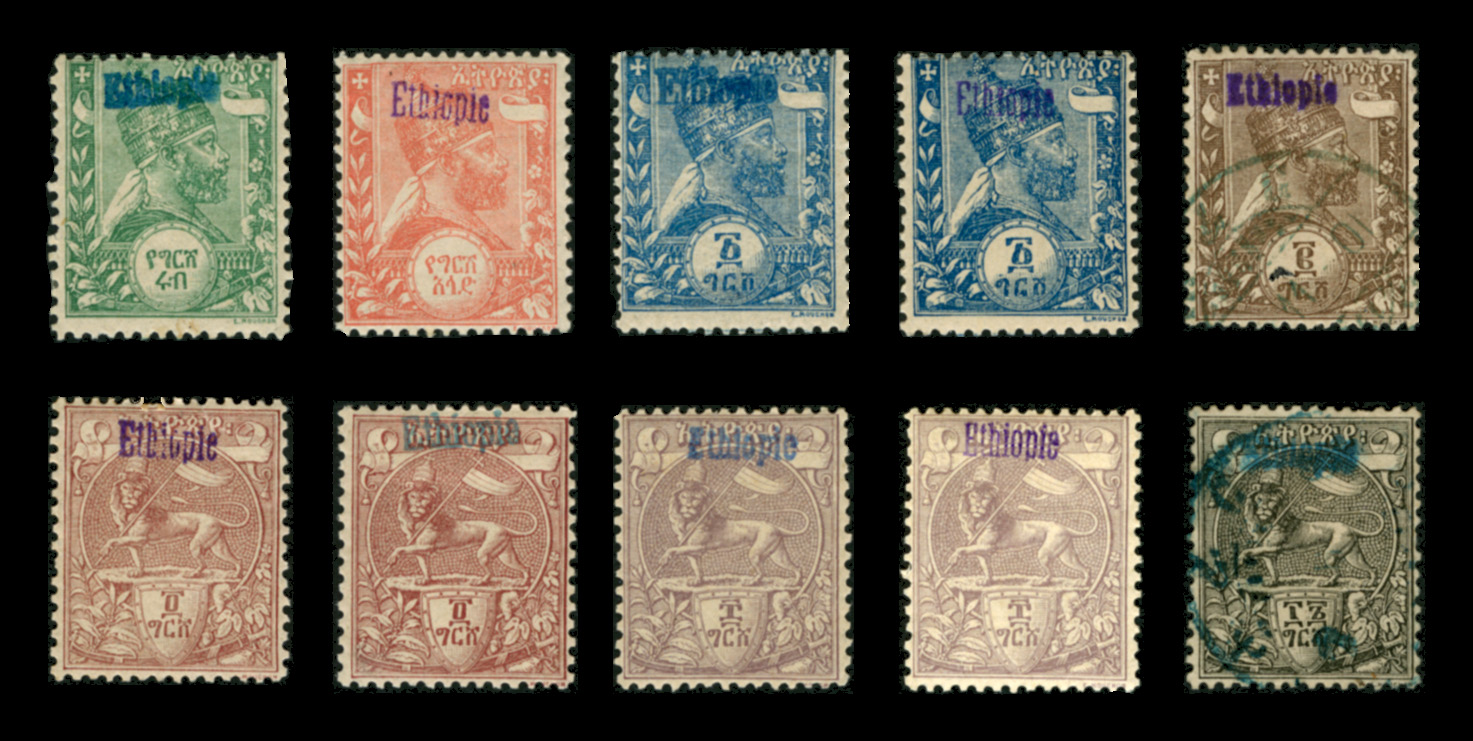
1901 - 1902. The second 'Ethiopie' overprint. Mint and used. (This is a mix of issues 1901, 1902 & 1906.)
Stanley Gibbons describes the Menelik II colours as (LTR) green, red, blue and brown. SG 15 - 18.
It describes the Lion of Judah colours as (LTR) red, mauve and black. SG 19 - 21.
The missing SG numbers 8 - 14 presumably relate to currency changes.
According to DOIG'S ETHIOPIA STAMP CATALOGUE,
Violet handstamp - Issued July 18, 1901, valid for postage. [Rare and underpriced in catalogues.]
During 1901-1902 postal use was primarily limited to the violet handstamp.
Blue handstamp - Issued in January, 1902, official reprint issued to supply collector demand, including CTO.
The blue is found mostly unused or cancelled during 1908.
As the first overprint was applied with a local handstamp the printing appears irregular. There were two different settings of this overprint. They are distinguished by the different size and shape of the leading 'E'. The overprint appears in several different colours. The central 8g mauve 'Lion of Judah' in the botton row above appears to have an 'Ethiopie' overprint that is different to the others. This is because there were two official reproductions by J. A. Michel, the Ethiopia Director of Posts, as well as an essay and various forgeries.
A seriffed handstanp was prepared by Michel to meet collector demand. His superior, Alfred Ilg, objected to their sale because he feared a further loss of revenue. However, Michel had his way and the second lot went to the Post Office from where at least one philatelic cover was despatched. The stamps are listed as "official reproductions" but not a later unauthorized issue made in 1906 to meet collector demand. These are also thought but not conclusively proven to have been the work of Michel. These are usually listed as a forgeries.
For a better understanding of this overprint, see DOIG's Ethiopia Stamp Catalogue. The Page below was prepared by Ulf Lindahl for Doig's impressively detailed 0n-line compendium.
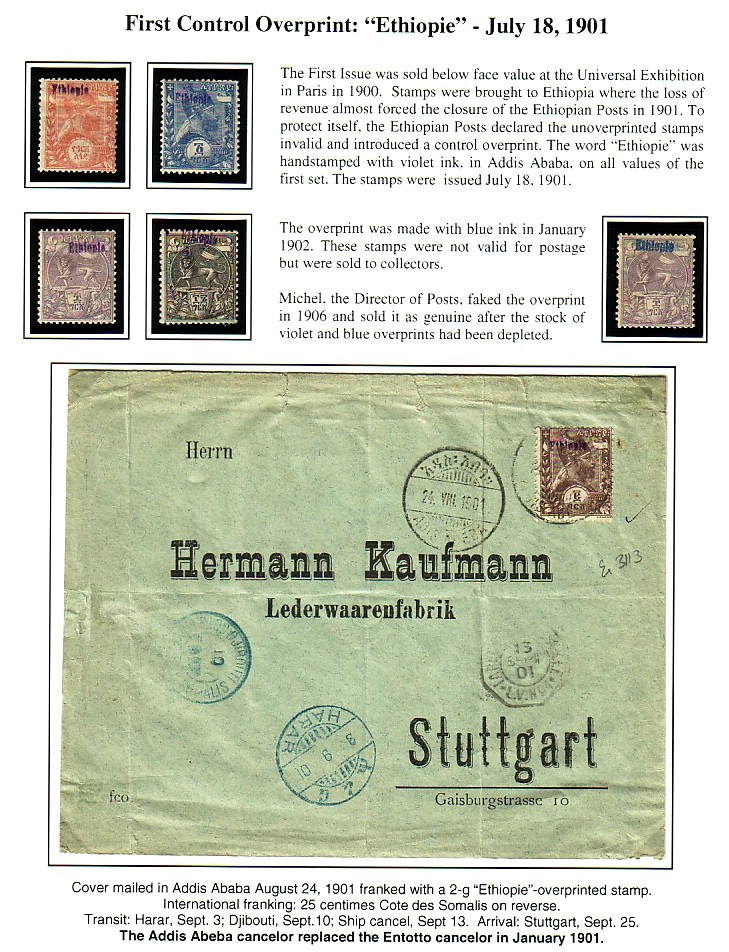
The two used stamps, right top and bottom above, appear to have Amharic datestamps cancelling them. Mint stamps of the first issue are likely to have originated from the stock that remained in Paris. However, as the purpose of the overprints was to prevent the loss of Ethiopian postal revenues by showing proof of a stamp's bona fides and provenance to the Ethiopian post office, one can reasonably assume that these mint overprints and used stamps cancelled with Amharic postmarks actually originated in Ethiopia.
*****
The Third Ethiopian Stamp issue is overprinted 'BOSTA': 1902 - 1903
To comply with the Emperor's edict, a further quantity of the first issue were overprinted with 'BOSTA' using a local handstamp.

- The overprint is 'BOSTA' in Amharic script', (meaning POSTS).
- ¼, ½, 1 and 2 guerch (g) with the portrait of Emperor Menelik II in profile,
- 4, 8, 16g values showing the heraldic Lion of Judah.
- The overprint was made in different colour inks.
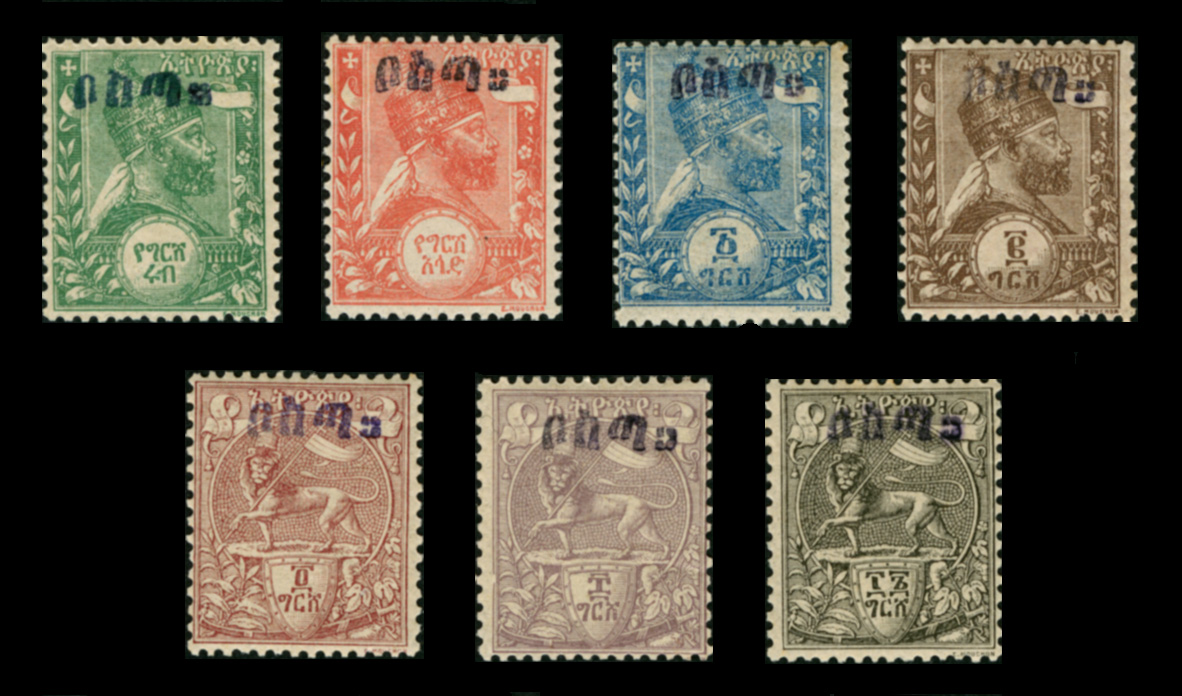
1902 - 1903. The third set of seven 'BOSTA' overprinted Ethiopian stamps. Mint.
Stanley Gibbons describes the Menelik II colours as (LTR) green, red, blue and brown. SG22 - 25.
It describes the Lion of Judah colours as (LTR) red, mauve and black. SG 26 - 28.
Made in 1902, the second overprint of the 1894 issue was the first in the Amharic language. It comprises four letters reading 'BOSTA', meaning 'POSTS'. Again this was printed in several different colour inks. The overprint concludes with a double colon. In written Amharic a single colon (:) is usually placed between every word to separate them. To indicate the end of a phrase or sentence a double colon (::) is used, writers in English would use a period or full stop. The double colon can be seen on the 'BOSTA::' 1902 overprint.
This Amharic overprint was viewed as a success. It was decided that future overprints would also be in Amharic script.
For a better understanding of this overprint, see DOIG's Ethiopia Stamp Catalogue. The Page below was prepared by Ulf Lindahl for Doig's impressively detailed on-line compendium.
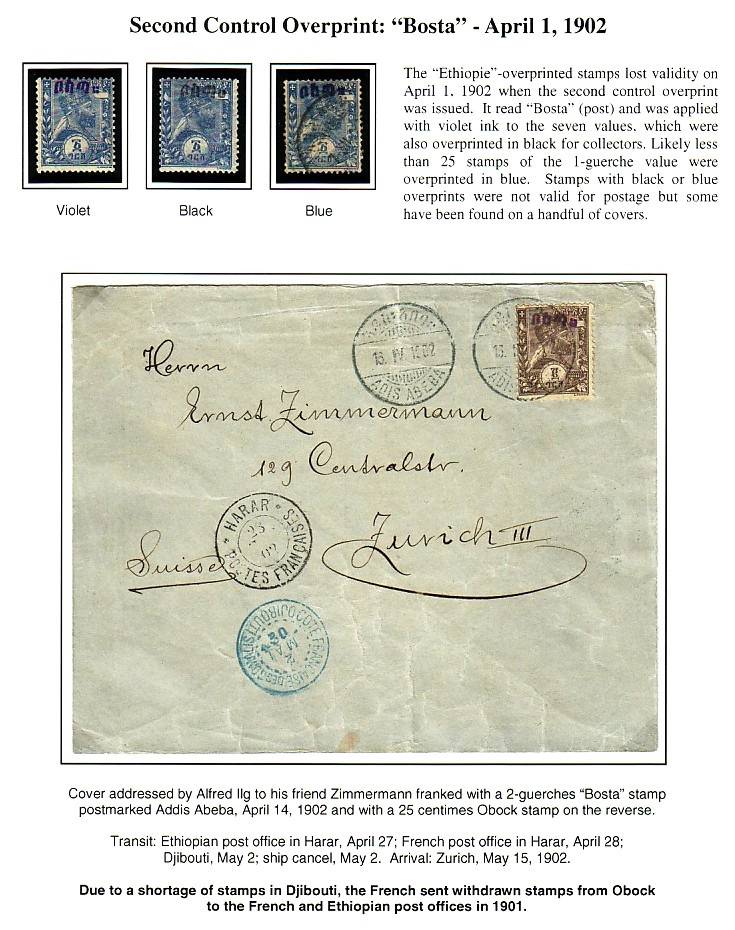
*****
The Fourth Ethiopian Stamp issue is overprinted 'MALEKT': 1903 - 1904
To comply with the Emperor's edict, a further quantity of the first issue were overprinted with 'MALEKT' using a local handstamp.

- The overprint is 'MALEKT' in Amharic script', (meaning MESSAGE).
- ¼, ½, 1 and 2 guerch (g) with the portrait of Emperor Menelik II in profile,
- 4, 8, 16g values showing the heraldic Lion of Judah.
- The overprint was made in different colour inks.
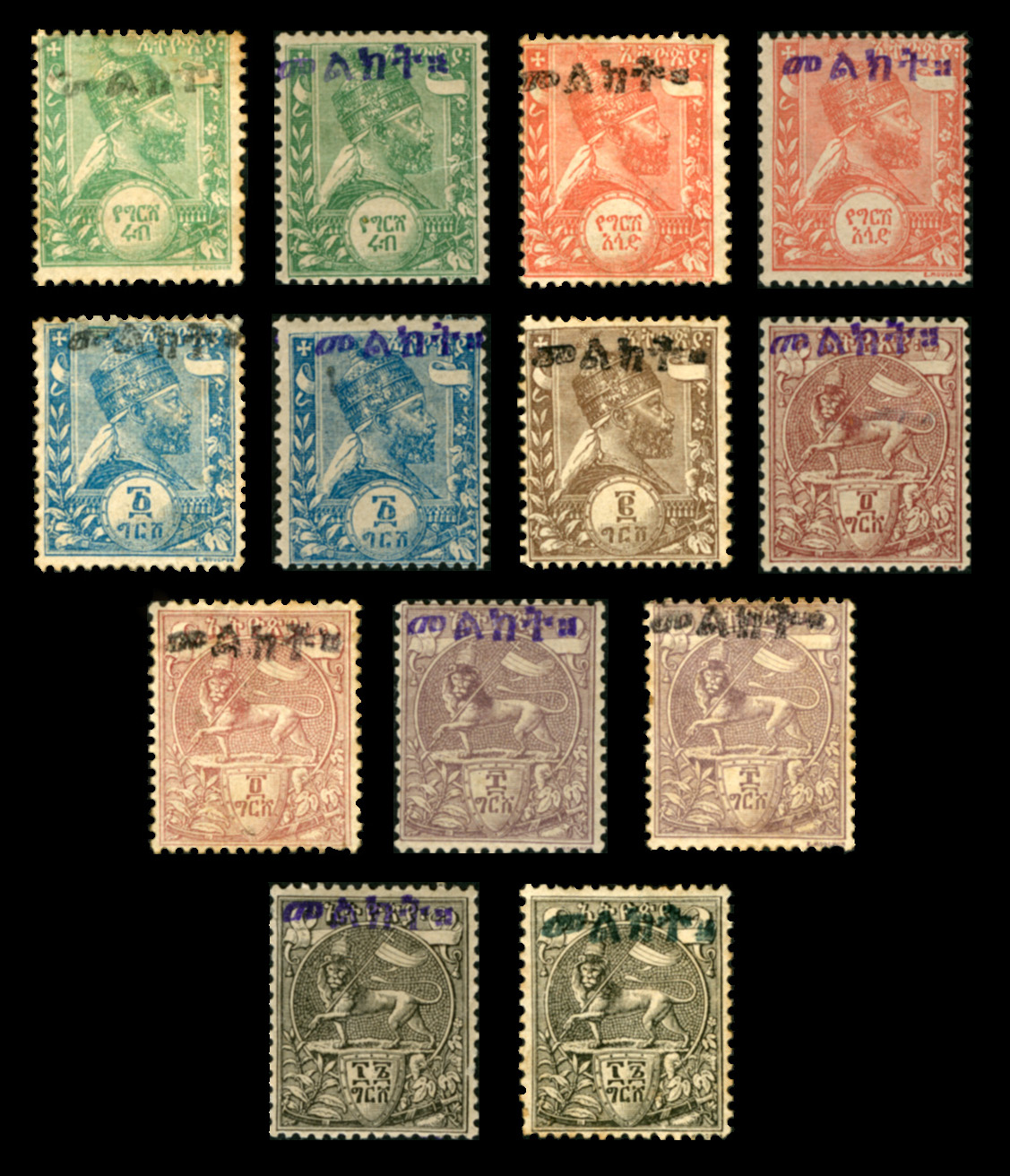
1903 - 1904. The fourth set of seven Ethiopian 'MALEKT' overprinted stamps. Mounted Mint.
Stanley Gibbons describes the Menelik II colours as (LTR) green, red, blue and brown. SG29 - 32.
It describes the Lion of Judah colours as (LTR) red, mauve and black. SG 33 - 35.
The 1902 Amharic overprint proved effective in both preventing the loss of revenue and increasing foreign interest in these exotc stamps. The overprinting with an Amharic handstamp was continued in 1903 when five letters reading 'MALEKT', meaning 'MESSAGE' were used. The final character is also a double colon (::) full stop. Of the overprint, Adler says this overprint is 'MALEKT' while Prof. Roberto Sciaky says 'MELIKT'. Whatever! It was, apparently, a spelling error which was corrected in the following overprint. The great Ethiopias expert, Ulf Lindahl, has a different explanation, saying this is 'MELEKT'.
For a better understanding of this overprint, see DOIG's Ethiopia Stamp Catalogue. The Page below was prepared by Ulf Lindahl for Doig's impressively detailed on-line compendium.
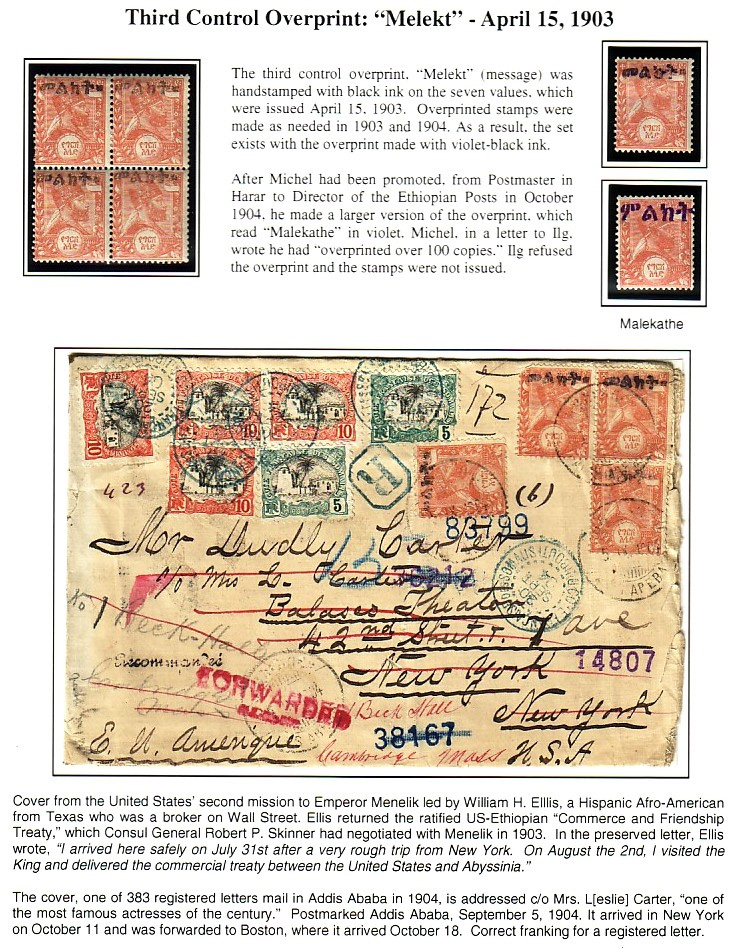
*****
The Fifth Ethiopian Stamp issue is overprinted 'MELEKT': 1904 - 1905
To comply with the Emperor's edict, a further quantity of the first issue were overprinted with 'MELEKT' using a local handstamp.

- The overprint is 'MELEKT' in Amharic script', (the correct spelling of MESSAGE).
- ¼, ½, 1 and 2 guerch (g) with the portrait of Emperor Menelik II in profile,
- 4, 8, 16g values showing the heraldic Lion of Judah.
- The overprint was made in different colour inks.
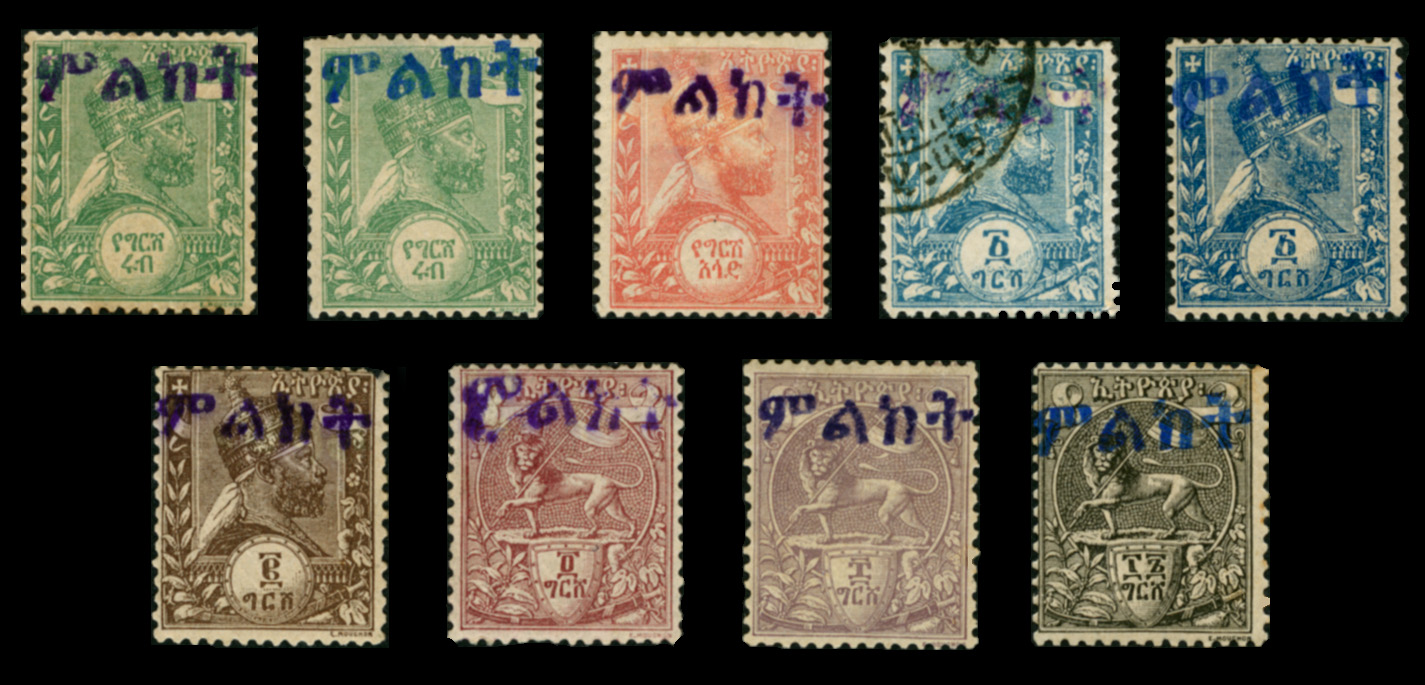
1904 - 1905. The fourth set of seven Ethiopian 'MELEKT' overprinted stamps. Mounted Mint & Used.
Stanley Gibbons describes the Menelik II colours as (LTR) green, red, blue and brown. SG36 - 39.
It describes the Lion of Judah colours as (LTR) red, mauve and black. SG 40 - 42.
This 1904 overprint uses larger Amharic characters and omits the double colon full stop. The overprint now reads 'MELEKT' which is the correct Amharic spelling of 'MESSAGE'. Again, several colours were used in this overprinting. One can probably assume that these different coloured overprints were made at different times as and when the needs of the Ethiopian post office required them.
*****
The Sixth Ethiopian Stamp issue is overprinted with New Currency Surcharges: 1905
In 1905 the relative simplicity of Ethiopian stamps to date was complicated by a change in currency. The new currency was the French Franc / centime. As a result, a further quantity of the first issue were overprinted with the stamps new values in the French currency.
- The overprint is the value in Arabic numerals.
- ¼, ½, 1 and 2 guerch (Menelik portrait) are overprinted 05, 1o, 20 and 40 centimes.
- 4, 8, 16g (Lion of Judah) values are overprinted 80 cenitmes. 1.60 and 3.20 Franc centimes.
- The overprint was made in different colour inks.
- Some remaining stocks of 1901 - 1904 sets were also overprinted
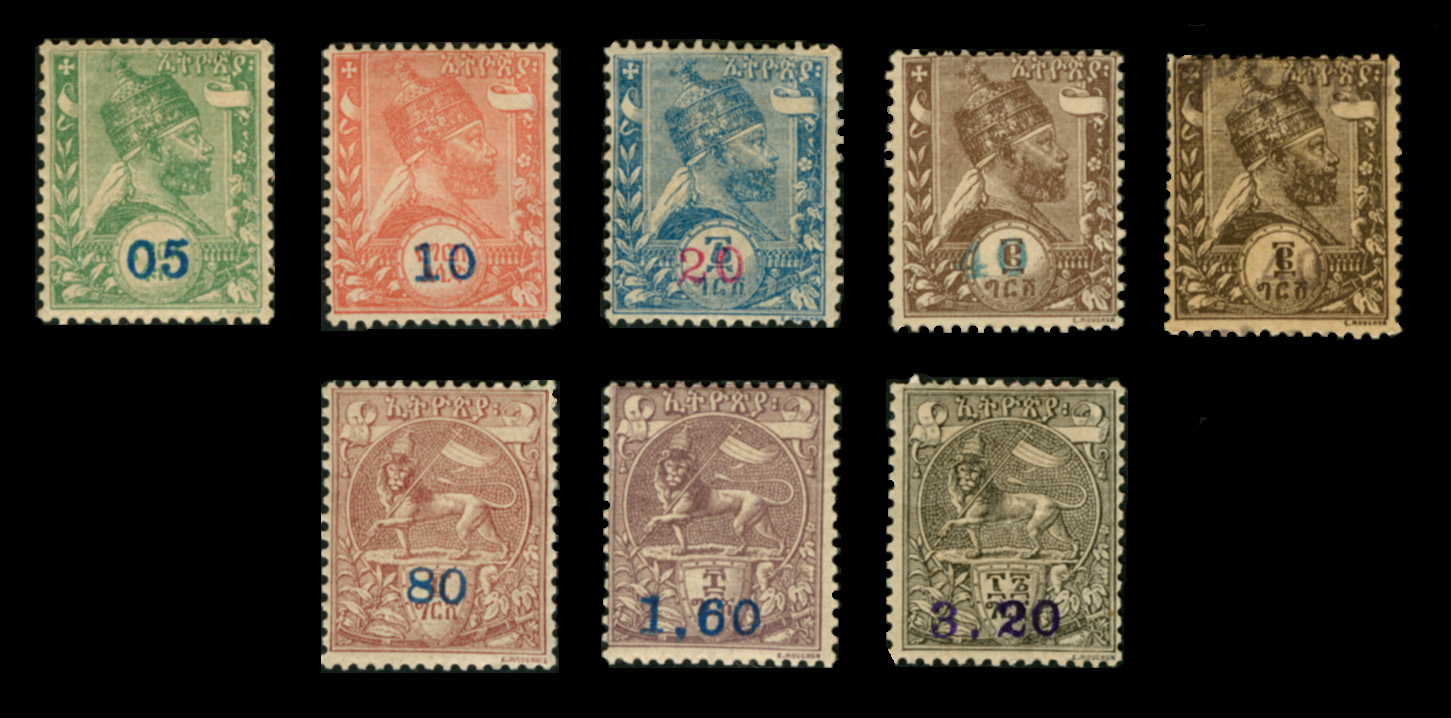
1905. The sixth set of seven Ethiopian stamps surcharged in Franc/centimes. Mounted Mint & Used.
These are the original stamps of 1894 surcharged in Franc/centimes. SG 43 - 49.
The first five are in centimes, the last two are in Francs and decimals thereof.
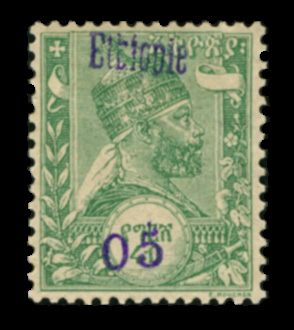
The Second Ethiopian Stamp issue overprinted 'ETHIOPIE' in 1901 - 1902 surcharged 05 centimes in 1905.
Note that this printed in violet, not blue. Overprinted '05' on SG 15.
For a better understanding of this overprint, see DOIG's Ethiopia Stamp Catalogue. The Page below was prepared by Ulf Lindahl for Doig's impressively detailed on-line compendium.
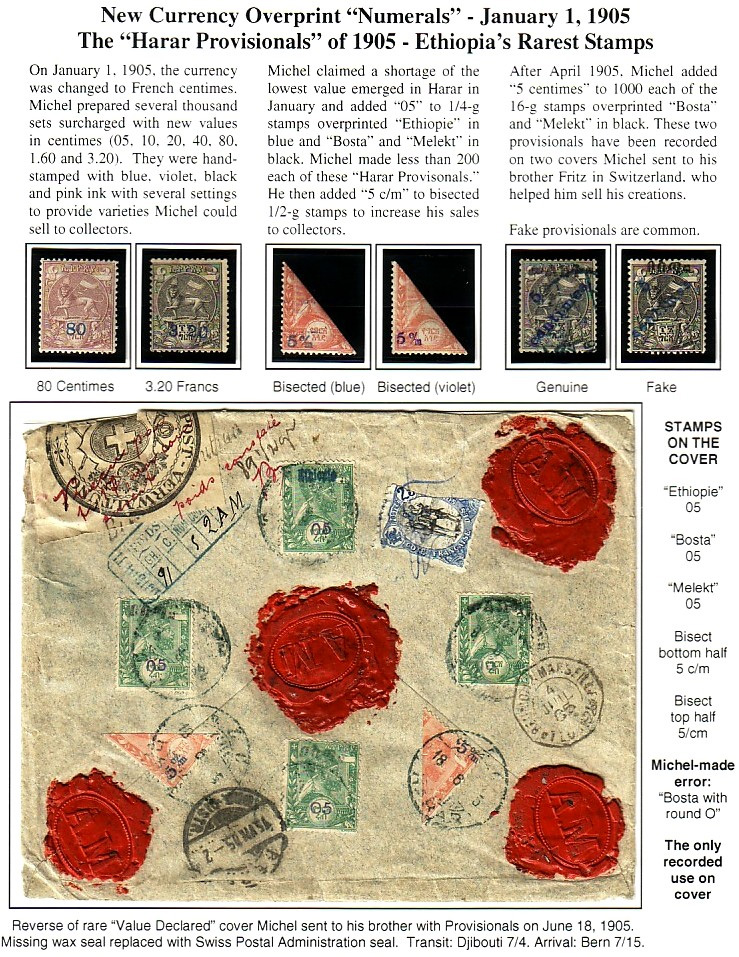
*****
Quote from Jamie Smith on February 20, 2024, 4:33 amBrilliant! Looking forward to the next posting. I can add a little Queen Elizabeth II when you reaach 5/2/65. Or are you going to do the South African invasion of 1941? Again I can add a couple.
I never realized the that Ethiopia also had a Lion with Flag emblem like Persia.
Brilliant! Looking forward to the next posting. I can add a little Queen Elizabeth II when you reaach 5/2/65. Or are you going to do the South African invasion of 1941? Again I can add a couple.
I never realized the that Ethiopia also had a Lion with Flag emblem like Persia.
Quote from Steve on February 20, 2024, 9:45 amMany thanks, Jamie. The brilliance is not mine but Lindahl's. My work is the slog, his material is the knockout slug.
The best of the material shown comes from the ETHIOPIAN PHILATELIC SOCIETY, in particular Ulf Lindahl's Early Ethiopia Gold Medal Exhibit. This also includes material from Prof Roberto Sciaky and also two South Africans known to you, Rory Ryan and Jim Findlay, whose 103 page study of East African APO is right up your military highway. Here is a LINK to that material. Enjoy!
Yes, I will keep posting but I am finding the early Ethioian overprints difficult. There are a lot of them including forgeries. I guess that overprinting is more typically found in a poor country that does not have the funds or the ability to make new issues at the drop of a hat.
I can post Ethiopian stamps and some covers up to the 1980s. I will cover the Italian invasions of 1896 and 1935 but will not specifically include the Allied / South African invasion / liberation in 1941. If you can add your material at that point that will be kind and very helpful and gratefully received. By all means add your QE2 material also. Its all grist for the mill. March on!
Did you know that....
Rastafarianism is an Africa-centred religion that developed in Jamaica in the 1930s after the coronation of Haile Selassie I (previously Prince Ras Tafari Makonnen) as Emperor of Ethiopia in 1930. It is a spiritual movement previously largely based on the belief in Selassie’s divinity, something he denied, and the return of ex-slaves to Zion, Africa. (In Ethiopia Emperor-worship has been central to its Coptic Christian tradition.) The Rastafarian movement earned global attention thanks to the Reggae music of Bob Marley, a devotee. The belief in Selassie as a living deity was delivered a blow with his murder in 1975 by Ethiopian communists. When Marley died prematurely of cancer in 1981 Rastafarianism lost its most influential exponent. Nevertheless, it endures wherever once poor, oppressed Black people make Reggae music and dance and cannabis is the drug of choice. In 2015 the Jamaican government decriminalized marijuana in order to better accomodate the island's Rastafarian culture and, not least, to increase tourism based on it.Re your "Lion with Flag emblem like Persia".
Reggae Rastafarian Lion of Judah Iron-on Patch
Many thanks, Jamie. The brilliance is not mine but Lindahl's. My work is the slog, his material is the knockout slug.
The best of the material shown comes from the ETHIOPIAN PHILATELIC SOCIETY, in particular Ulf Lindahl's Early Ethiopia Gold Medal Exhibit. This also includes material from Prof Roberto Sciaky and also two South Africans known to you, Rory Ryan and Jim Findlay, whose 103 page study of East African APO is right up your military highway. Here is a LINK to that material. Enjoy!
Yes, I will keep posting but I am finding the early Ethioian overprints difficult. There are a lot of them including forgeries. I guess that overprinting is more typically found in a poor country that does not have the funds or the ability to make new issues at the drop of a hat.
I can post Ethiopian stamps and some covers up to the 1980s. I will cover the Italian invasions of 1896 and 1935 but will not specifically include the Allied / South African invasion / liberation in 1941. If you can add your material at that point that will be kind and very helpful and gratefully received. By all means add your QE2 material also. Its all grist for the mill. March on!
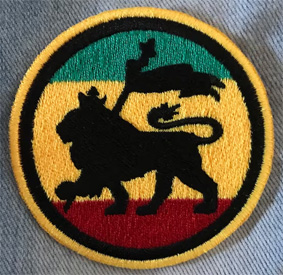
Did you know that....
Rastafarianism is an Africa-centred religion that developed in Jamaica in the 1930s after the coronation of Haile Selassie I (previously Prince Ras Tafari Makonnen) as Emperor of Ethiopia in 1930. It is a spiritual movement previously largely based on the belief in Selassie’s divinity, something he denied, and the return of ex-slaves to Zion, Africa. (In Ethiopia Emperor-worship has been central to its Coptic Christian tradition.) The Rastafarian movement earned global attention thanks to the Reggae music of Bob Marley, a devotee. The belief in Selassie as a living deity was delivered a blow with his murder in 1975 by Ethiopian communists. When Marley died prematurely of cancer in 1981 Rastafarianism lost its most influential exponent. Nevertheless, it endures wherever once poor, oppressed Black people make Reggae music and dance and cannabis is the drug of choice. In 2015 the Jamaican government decriminalized marijuana in order to better accomodate the island's Rastafarian culture and, not least, to increase tourism based on it.
Re your "Lion with Flag emblem like Persia".
Reggae Rastafarian Lion of Judah Iron-on Patch
Quote from Steve on February 21, 2024, 11:08 amThe Two 'Menelik' Overprints: January and July 1906
The use of the Emperor’s name was an attempt to counter a circle within the Ethiopian nobility who argued that too much dependance was being placed on foreign countries, notably Britain and France. This clique employed the emotive nationalist slogan ‘Ethiopia for the Ethiopians’. At the same time a rumuour intended to undermine Menilik II was circulating that he had died. The use of his name as an overprint stressed his Ethiopioness and that he was still very much alive.
The First 'Menelik' Overprint: 1st January 1906
According to Adler, "the early" (ie. First) "overprint now took the form of the Emperor's name writen in Amharic overprinted on the otherwise unoverprinted 1905 new currency set of seven values" ie. the January 1906 issue combined the new 'Menelik' overprint with 1905 surcharges. "This overprint was made in Addis Ababa and also in Harrar". Michel claimed that the shorter version was made for use in Addis Ababa and the longer, wider one for use in Harar. Lindahl states that both versions "were used in Harar and Addis Ababa".
- The 1906 (January 1st) issue is overprinted 'Menelik'.
- There are two versions: short (Addis Ababa) and longer, wide (Harar).
- There is no double colon full stop.
- The overprint was made in different colour inks.
- The stamp is the 1905 surcharge with the values in Arabic numerals.
Page prepared by Ulf Lindahl for Doig's Stamp Catalogue
The Second 'Menelik' Overprint: 1st July 1906
A second issue much like the first was meticulously prepared by Michel. This had a new 'Menelik' overprint and new value surcharges, both printed in the same colour ink. According to Lindahl,it comprised "seven individually prepared handstamps - one for each value". (Sadly, he only shows us four values.) This issue has been extensively faked, not least by Michel. This issue has two distinguishing features, the first being a double colon full stop after Menelik and the second being the relatively unique violet-red ink used.
- The 1906 (July 1st) issue is overprinted 'Menelik'.
- There is a double colon full stop after 'Menelik'.
- The overprint and surcharge were made in the same violet-red ink.
- The stamp used is the 1894 printing issued in 1895.
While the first two (left of centre) do appear to be reasonably genuine examples of the 1906 (July 1st) issue, the same cannot be said for the two (right of centre) given the high level of faked stamps found among this issue.
Page prepared by Ulf Lindahl for Doig's Stamp Catalogue
The Two 'Menelik' Overprints: January and July 1906
The use of the Emperor’s name was an attempt to counter a circle within the Ethiopian nobility who argued that too much dependance was being placed on foreign countries, notably Britain and France. This clique employed the emotive nationalist slogan ‘Ethiopia for the Ethiopians’. At the same time a rumuour intended to undermine Menilik II was circulating that he had died. The use of his name as an overprint stressed his Ethiopioness and that he was still very much alive.
The First 'Menelik' Overprint: 1st January 1906
According to Adler, "the early" (ie. First) "overprint now took the form of the Emperor's name writen in Amharic overprinted on the otherwise unoverprinted 1905 new currency set of seven values" ie. the January 1906 issue combined the new 'Menelik' overprint with 1905 surcharges. "This overprint was made in Addis Ababa and also in Harrar". Michel claimed that the shorter version was made for use in Addis Ababa and the longer, wider one for use in Harar. Lindahl states that both versions "were used in Harar and Addis Ababa".

- The 1906 (January 1st) issue is overprinted 'Menelik'.
- There are two versions: short (Addis Ababa) and longer, wide (Harar).
- There is no double colon full stop.
- The overprint was made in different colour inks.
- The stamp is the 1905 surcharge with the values in Arabic numerals.
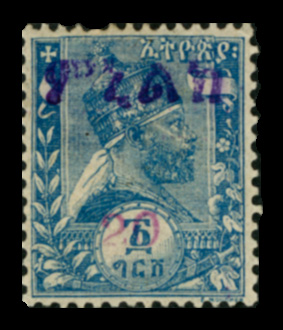
Page prepared by Ulf Lindahl for Doig's Stamp Catalogue
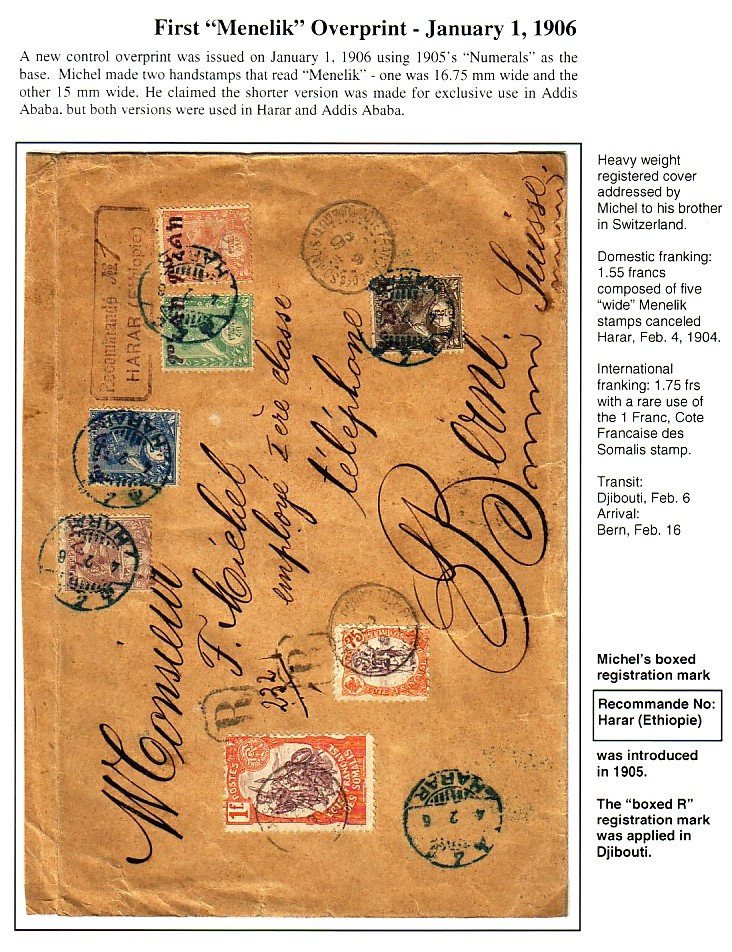
The Second 'Menelik' Overprint: 1st July 1906
A second issue much like the first was meticulously prepared by Michel. This had a new 'Menelik' overprint and new value surcharges, both printed in the same colour ink. According to Lindahl,it comprised "seven individually prepared handstamps - one for each value". (Sadly, he only shows us four values.) This issue has been extensively faked, not least by Michel. This issue has two distinguishing features, the first being a double colon full stop after Menelik and the second being the relatively unique violet-red ink used.

- The 1906 (July 1st) issue is overprinted 'Menelik'.
- There is a double colon full stop after 'Menelik'.
- The overprint and surcharge were made in the same violet-red ink.
- The stamp used is the 1894 printing issued in 1895.

While the first two (left of centre) do appear to be reasonably genuine examples of the 1906 (July 1st) issue, the same cannot be said for the two (right of centre) given the high level of faked stamps found among this issue.
Page prepared by Ulf Lindahl for Doig's Stamp Catalogue
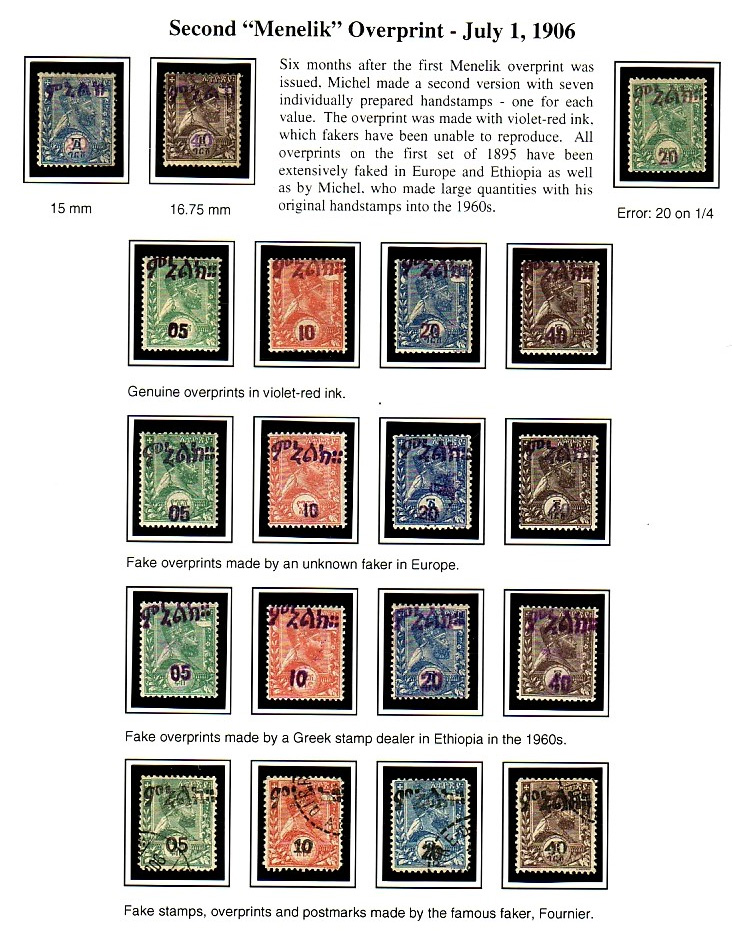
Quote from Steve on February 21, 2024, 6:04 pmThe Early POSTAGE DUE Stamps of Ethiopia
The Unissued 'ASKEFIL' Postage Dues: 1896
The 1894 issue has the high values on 'Lion of Judah' stamps. So what are these?
The Ethiopian stamps below show six of seven values on stamps bearing the Menelik portrait. Apparently all were printed at the same time as the 1894 issue which has its high values on Lion of Judah stamps. In 1896 someone made a decision to convert the Menelik stamps to Postage Dues. The difference between these and the 1894 issue is that these stamps were never issued or used in Ethiopia.
Exactly who authorised the Postage Dues and why is a matter of debate and conjecture. Certainly someone or parties with vested interests and the authority to command their printing hoped to profit from them. The pretext given was that they were being printed for the Ethiopian Post Office. As a result sheets of stamps bearing the Menelik portrait were overprinted with the phrase 'ASKEFIL', (Amharic. let him pay). This was typographically presented in an ornate decorative scroll running diagonally across the stamp.
Unlike the random placement of the preceding handstamped overprints the neat and largely uniform 'ASKEFIL' scroll suggests that entire sheets were overprinted by printers who knew what they were doing. Despite being printed on genuine Ethiopian stamps these Postage Dues were NEVER used in Ethiopia by its Post Office. As a result, they are not listed in some stamp catalogues, specifically Stanley Gibbons. Nevertheless, they are attractive items with a controversial historic value that many collectors will pay for.
- All seven stamps show the portrait of Menelik II. (Six shown below).
- The phrase 'ASKEFIL' appears in a diagonal scroll.
- The red stamp of the 1895 issue has been substituted with a brown one.
- There is no double colon full stop after 'ASKEFIL'' ie. its use on stamps appears arbitary.
The fraudster in this 'affaire de philatelie' was Arthur Maury, doyen of French philately, author, stamp dealer and forger, a man so in love with his philatelic muse he would gladly fake stamps in order profit from the pleasure they gave collectors. (He reminds me of a little of A. A. Jurgens, another insecure 'expert' who craved the adulation of his peers!) Maury was involved in the printing of the first issue of Ethiopia in 1894 (issued 1895). It was Maury who made these unissued Postage Due overprints available to collectors. Indeed, he even went to far as to state that the date of their official issue in Ethiopia was 'February, 1896'. He began selling these in October, 1896. "Maury, tu es une merde de pute."
Page prepared by Ulf Lindahl for Doig's Stamp Catalogue
Sadly, I am at present unable to show examples of the Postage Due 'T' and 'Taxe & Percevoir,' as seen above.
The 'ASKEFIL in Triangle' Postage Dues: 1908
It is very interesting to read below what Lindadah;s says about "The French continued Michel's practice ff making deliberate errors". Also, there is an interesting note about how many first issue stamps came to Ethiopia, some 945,000) and how many were sold. According to Lindahl, between 1895 to 1911, the total number of Ethiopian first issue (1894) stamps sold with and without overprints was a mere 660, 263. Among these were the seven values of the 1908 Postage Dues. See Lindahl's sheet below.
Page prepared by Ulf Lindahl for Doig's Stamp Catalogue
To be continued .....
The Early POSTAGE DUE Stamps of Ethiopia
The Unissued 'ASKEFIL' Postage Dues: 1896

The 1894 issue has the high values on 'Lion of Judah' stamps. So what are these?
The Ethiopian stamps below show six of seven values on stamps bearing the Menelik portrait. Apparently all were printed at the same time as the 1894 issue which has its high values on Lion of Judah stamps. In 1896 someone made a decision to convert the Menelik stamps to Postage Dues. The difference between these and the 1894 issue is that these stamps were never issued or used in Ethiopia.
Exactly who authorised the Postage Dues and why is a matter of debate and conjecture. Certainly someone or parties with vested interests and the authority to command their printing hoped to profit from them. The pretext given was that they were being printed for the Ethiopian Post Office. As a result sheets of stamps bearing the Menelik portrait were overprinted with the phrase 'ASKEFIL', (Amharic. let him pay). This was typographically presented in an ornate decorative scroll running diagonally across the stamp.
Unlike the random placement of the preceding handstamped overprints the neat and largely uniform 'ASKEFIL' scroll suggests that entire sheets were overprinted by printers who knew what they were doing. Despite being printed on genuine Ethiopian stamps these Postage Dues were NEVER used in Ethiopia by its Post Office. As a result, they are not listed in some stamp catalogues, specifically Stanley Gibbons. Nevertheless, they are attractive items with a controversial historic value that many collectors will pay for.
- All seven stamps show the portrait of Menelik II. (Six shown below).
- The phrase 'ASKEFIL' appears in a diagonal scroll.
- The red stamp of the 1895 issue has been substituted with a brown one.
- There is no double colon full stop after 'ASKEFIL'' ie. its use on stamps appears arbitary.

The fraudster in this 'affaire de philatelie' was Arthur Maury, doyen of French philately, author, stamp dealer and forger, a man so in love with his philatelic muse he would gladly fake stamps in order profit from the pleasure they gave collectors. (He reminds me of a little of A. A. Jurgens, another insecure 'expert' who craved the adulation of his peers!) Maury was involved in the printing of the first issue of Ethiopia in 1894 (issued 1895). It was Maury who made these unissued Postage Due overprints available to collectors. Indeed, he even went to far as to state that the date of their official issue in Ethiopia was 'February, 1896'. He began selling these in October, 1896. "Maury, tu es une merde de pute."
Page prepared by Ulf Lindahl for Doig's Stamp Catalogue
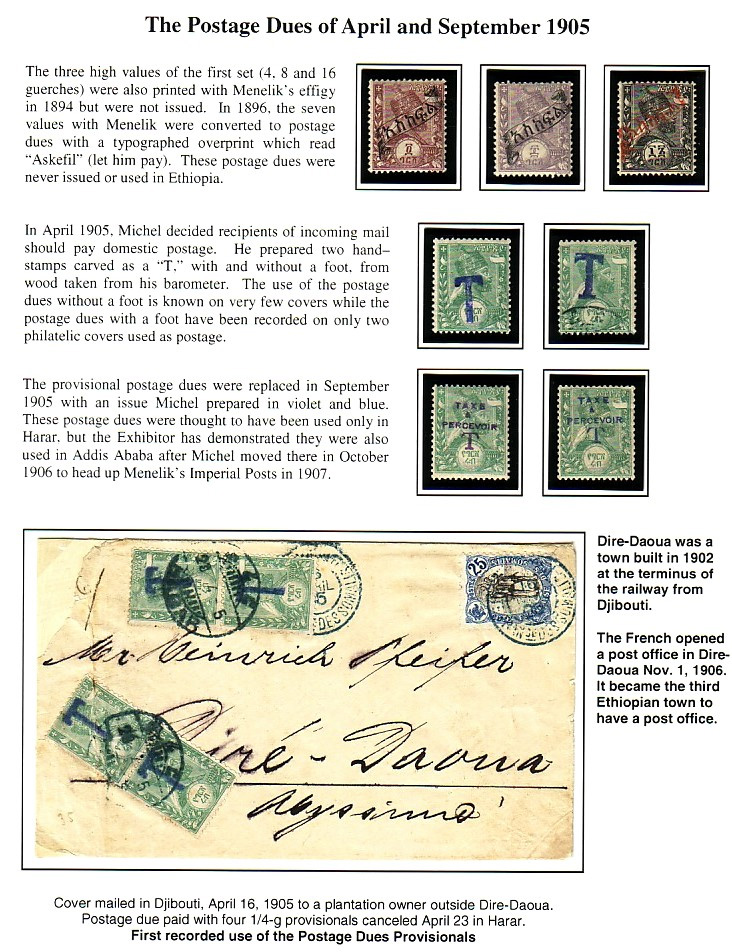
Sadly, I am at present unable to show examples of the Postage Due 'T' and 'Taxe & Percevoir,' as seen above.
The 'ASKEFIL in Triangle' Postage Dues: 1908
It is very interesting to read below what Lindadah;s says about "The French continued Michel's practice ff making deliberate errors". Also, there is an interesting note about how many first issue stamps came to Ethiopia, some 945,000) and how many were sold. According to Lindahl, between 1895 to 1911, the total number of Ethiopian first issue (1894) stamps sold with and without overprints was a mere 660, 263. Among these were the seven values of the 1908 Postage Dues. See Lindahl's sheet below.
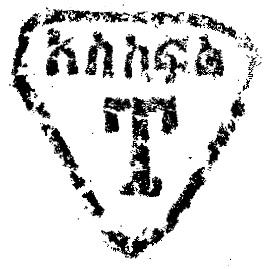

Page prepared by Ulf Lindahl for Doig's Stamp Catalogue
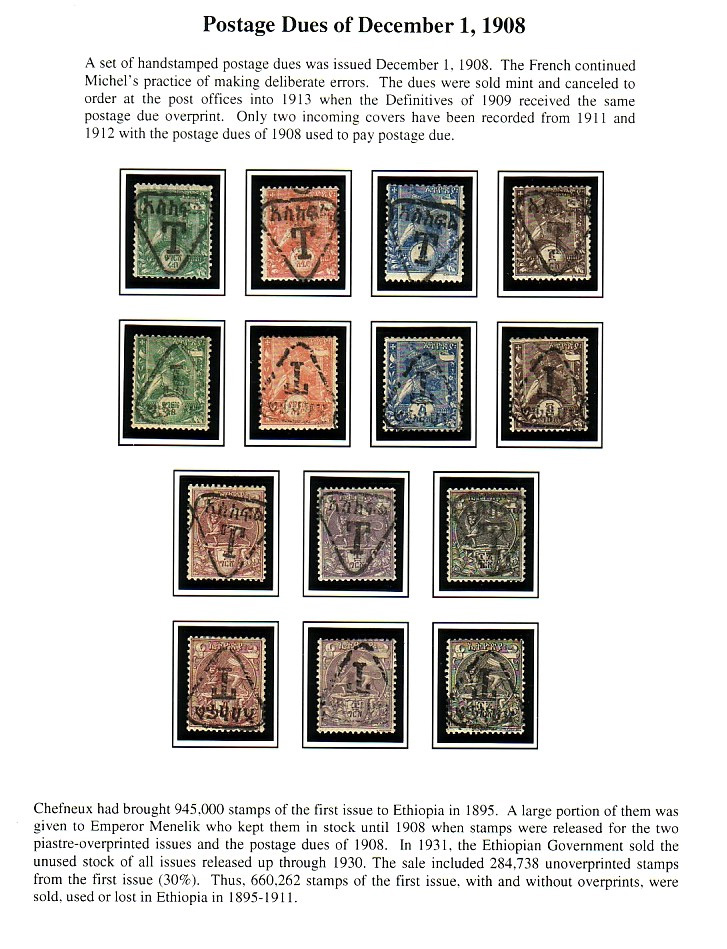 To be continued .....
To be continued .....
Quote from Jamie Smith on February 29, 2024, 8:34 amIf the Lord gives me a second round I think I might extend my Ethiopia. I hadn't realised how deep it was! In the meantime back to what I have. Again thanks for the postings, keep them coming.
If the Lord gives me a second round I think I might extend my Ethiopia. I hadn't realised how deep it was! In the meantime back to what I have. Again thanks for the postings, keep them coming.

